My most current blog entry:
Entries in Castles of Scotland (35)
Visitors From Thailand In April - Time to see the country!
 Saturday, August 30, 2014 at 6:08PM
Saturday, August 30, 2014 at 6:08PM Scotland It's always great to get visitors. In April we had good friends, three couples, visit us from Thailand. I had a week off, so it was a great opportunity to further explore Scotland . . . and London.
It's always great to get visitors. In April we had good friends, three couples, visit us from Thailand. I had a week off, so it was a great opportunity to further explore Scotland . . . and London.
 The weather couldn't have been any better: bright, clear, crisp, with fast moving clouds.
The weather couldn't have been any better: bright, clear, crisp, with fast moving clouds.
 It was fun to take our friends to some of our favorite beauty spots.
It was fun to take our friends to some of our favorite beauty spots.
 Of course a distillery tour was on the tour.
Of course a distillery tour was on the tour.
 It was a scrumptious day for a road trip along the Highlands Malt Whiskey Trail.
It was a scrumptious day for a road trip along the Highlands Malt Whiskey Trail.
 We paid took the full tour (with sampling!) of the Royal Lochnagar Distillery . . . that strictly forbade photography.
We paid took the full tour (with sampling!) of the Royal Lochnagar Distillery . . . that strictly forbade photography.
 The old whiskey still itself was a wonder of craftsmanship, detail, color and texture.
The old whiskey still itself was a wonder of craftsmanship, detail, color and texture.
 The stills were works of art.
The stills were works of art.
 The whiskey barrel vault . . . and royal patronage emblem. This stuff is valuable.
The whiskey barrel vault . . . and royal patronage emblem. This stuff is valuable.
 I can confirm the whiskey advertisements . . . whiskey is still made the old fashioned way.
I can confirm the whiskey advertisements . . . whiskey is still made the old fashioned way.
 Because of the alcohol vapors present, all electrical switches have to be sealed. This light switch must have been installed when the distillery was first electrified.
Because of the alcohol vapors present, all electrical switches have to be sealed. This light switch must have been installed when the distillery was first electrified.
 Water, Sparge, Sparge, and Hot Wart. Of course.
Water, Sparge, Sparge, and Hot Wart. Of course.
 Old brass Victorian-era distillery devices were still in use. It also supplied a nice opportunity for a novel self-portrait.
Old brass Victorian-era distillery devices were still in use. It also supplied a nice opportunity for a novel self-portrait.
 Our visitors are whiskey lovers, but didn't like this particular single malt. We left the beautiful surrounds of the distillery to head further up into the Scottish Highlands.
Our visitors are whiskey lovers, but didn't like this particular single malt. We left the beautiful surrounds of the distillery to head further up into the Scottish Highlands.
 The Highlands early spring roads are magnificent.
The Highlands early spring roads are magnificent.
 Our next stop was Balmoral Castle, the summer residence of The Queen of England.
Our next stop was Balmoral Castle, the summer residence of The Queen of England.
 The moss and lichens on this stone banister gives you some idea of how wet the highlands can be in the winter. Lovely textures!
The moss and lichens on this stone banister gives you some idea of how wet the highlands can be in the winter. Lovely textures!
 Yes, there really are castles like this in the world . . that are lived in by real queens.
Yes, there really are castles like this in the world . . that are lived in by real queens.
 Balmoral Castle is actually the private property of the Royal Family, unlike all the other Royal residencies which are the property of the State.
Balmoral Castle is actually the private property of the Royal Family, unlike all the other Royal residencies which are the property of the State.
 Balmoral Castle lies astride the trout and salmon laden upper reaches of the River Dee.
Balmoral Castle lies astride the trout and salmon laden upper reaches of the River Dee.
 We could have stayed all day taking selfies n front of Balmoral Castle . . . the archetypical royal castle.
We could have stayed all day taking selfies n front of Balmoral Castle . . . the archetypical royal castle.
 The best liquor we had that day was the hooch our van driver Karl shared.
The best liquor we had that day was the hooch our van driver Karl shared.
LONDON - The Harry Potter Studio Tour
 Yes, we went here.
Yes, we went here.
 I confess, I am not a fan of this kind of fantasy literature and/or the cinematic spin-offs they generate. It's just not my cup of tea.
I confess, I am not a fan of this kind of fantasy literature and/or the cinematic spin-offs they generate. It's just not my cup of tea.
 We flew to London and went directly to the WB Harry Potter Studios . . . I went screaming and kicking, not being a fan of this sort of thing.
We flew to London and went directly to the WB Harry Potter Studios . . . I went screaming and kicking, not being a fan of this sort of thing.
 But . . . I have to admit that the tour turned out much, much better than I could have hoped.
But . . . I have to admit that the tour turned out much, much better than I could have hoped.
 It turned out to be an actual tour of the actual sets used in the actual movies in the actual studio where it was actually filmed. My dread was dissolved.
It turned out to be an actual tour of the actual sets used in the actual movies in the actual studio where it was actually filmed. My dread was dissolved.
 I've only ever seen one of these Harry Potter movies, the first one, and I assumed most of the scenes were computer generated CGI art . . . it wasn't!!!
I've only ever seen one of these Harry Potter movies, the first one, and I assumed most of the scenes were computer generated CGI art . . . it wasn't!!!
 The detail of the set construction was truly impressive. They went to a lot of work (and expense!) to create this imaginary world.
The detail of the set construction was truly impressive. They went to a lot of work (and expense!) to create this imaginary world.
 The production went to a lot of trouble . . . . including working from detailed architectural drawings, to . . .
The production went to a lot of trouble . . . . including working from detailed architectural drawings, to . . .
 . . . to constructing scale models of sets. The workmanship is excellent. This is a big production . . . unlike my own forays into Hollywood productions.
. . . to constructing scale models of sets. The workmanship is excellent. This is a big production . . . unlike my own forays into Hollywood productions.
 A fantasy of a fantasy of a fantasy: a post-modern copy of a copy of a copy of an apothecary shop that never was.
A fantasy of a fantasy of a fantasy: a post-modern copy of a copy of a copy of an apothecary shop that never was.
 The autonomatronic creatures were impressive, as was the workshop where they were made.
The autonomatronic creatures were impressive, as was the workshop where they were made.
 Character prosthetics. I want one for Holloween.
Character prosthetics. I want one for Holloween.
 Again, the attention to detail in the costumes was way beyond what I expected.
Again, the attention to detail in the costumes was way beyond what I expected.
 I posted this one on Facebook as "Inside the Obama fake voter labs" . . . to much Democratic acclaim and vitriol from the ever-present trolls.
I posted this one on Facebook as "Inside the Obama fake voter labs" . . . to much Democratic acclaim and vitriol from the ever-present trolls.
 The model of the school was 50 feet tall and perfect in detail.
The model of the school was 50 feet tall and perfect in detail.
 Amazing, just amazing.
Amazing, just amazing.
 The Harry Potter Flying Broom Machine . . . seems like these would be popular at Chucky Cheese at $5.oo a ride. The background is a green screen (chroma key) used in CGI imagery.
The Harry Potter Flying Broom Machine . . . seems like these would be popular at Chucky Cheese at $5.oo a ride. The background is a green screen (chroma key) used in CGI imagery.
 My new computer desktop image. After an impressive three hours in the studio, all exits funneled us to the vast and expensive GIFT SHOP FROM HELL. The child-whining there was epic. And shrill. And tearful. An 'official' Harry Potter Magic Wand (a stick) was a money-gouging 55 pounds (US$75.oo). Ouch. This image is of how hard parents feel it is to get out of the aforementioned Gift Shop From Hell. Off to London without so much as a key chain fob, such is the strength of my will.
My new computer desktop image. After an impressive three hours in the studio, all exits funneled us to the vast and expensive GIFT SHOP FROM HELL. The child-whining there was epic. And shrill. And tearful. An 'official' Harry Potter Magic Wand (a stick) was a money-gouging 55 pounds (US$75.oo). Ouch. This image is of how hard parents feel it is to get out of the aforementioned Gift Shop From Hell. Off to London without so much as a key chain fob, such is the strength of my will.
LONDON
 An hour drive into central London landed us in beautiful Knightsbridge. It was a nostalgic journey for me: I lived in London for several years in the late 80s. As you can see, London is much further south than Aberdeen, and was in full new-growth Springtime.
An hour drive into central London landed us in beautiful Knightsbridge. It was a nostalgic journey for me: I lived in London for several years in the late 80s. As you can see, London is much further south than Aberdeen, and was in full new-growth Springtime.
 Ah, London Pubs!
Ah, London Pubs!
 This photo is perhaps more indicative of London's neighborhoods than Big Ben. London is very multicultural.
This photo is perhaps more indicative of London's neighborhoods than Big Ben. London is very multicultural.
 London may be the finest tourist city in the world.
London may be the finest tourist city in the world.
 Trafalgar Square . . . tourist central.
Trafalgar Square . . . tourist central.
 A must-have-tourist-experience in London.
A must-have-tourist-experience in London.
 These acrobatic Swedish tourists put on quite a show for a Japanese tour group.
These acrobatic Swedish tourists put on quite a show for a Japanese tour group.
 London is a very open-minded city.
London is a very open-minded city.
 London is such a visually rich city . . there are literally too many things to photograph . . . that you want to photograph. I was on sensory overload the whole time. I wouldn't mind living in London again.
London is such a visually rich city . . there are literally too many things to photograph . . . that you want to photograph. I was on sensory overload the whole time. I wouldn't mind living in London again.
 Having good clean fun in London. It is good to have older sisters.
Having good clean fun in London. It is good to have older sisters.
 Yes, we frequented hi-brow cafes and sampled delicious cakes and edible whatnots. I brought my medication.
Yes, we frequented hi-brow cafes and sampled delicious cakes and edible whatnots. I brought my medication.
 Where the rich and famous hang out in Knightsbridge.
Where the rich and famous hang out in Knightsbridge.
 People say that the food is bad in London. Not So!!! We had excellent Korean, Chinese, Thai, Turkish, Lebanese, and Indian food throughout the whole trip. The aftermath of a great Korean meal near Trafalgar.
People say that the food is bad in London. Not So!!! We had excellent Korean, Chinese, Thai, Turkish, Lebanese, and Indian food throughout the whole trip. The aftermath of a great Korean meal near Trafalgar.
 I think the real reason our Thai friends wonted to visit London was to take a pilgrimage to Harrods . . . The Temple of Shopping!!!!
I think the real reason our Thai friends wonted to visit London was to take a pilgrimage to Harrods . . . The Temple of Shopping!!!!
 And when I say Harrods is a Temple of Shopping, I MEAN Temple of Shopping. This is the escalator in Harrods Department Store.
And when I say Harrods is a Temple of Shopping, I MEAN Temple of Shopping. This is the escalator in Harrods Department Store.
 We caught London at the very beginning of the Spring blossoms. Nice.
We caught London at the very beginning of the Spring blossoms. Nice.
 London is both an ancient and a modern city . . . but it feels like it is in a human scale . . .
London is both an ancient and a modern city . . . but it feels like it is in a human scale . . .
 London from the steps of the gallery, Tate Britain.
London from the steps of the gallery, Tate Britain.
 OK, not entirely on a human scale. Prince Charles let this thing get by his architectural scrutineering.
OK, not entirely on a human scale. Prince Charles let this thing get by his architectural scrutineering.
 I remember lots of parks in London for my daughter to play in when we lived there . . . it's still a pretty good city for children.
I remember lots of parks in London for my daughter to play in when we lived there . . . it's still a pretty good city for children.
 I HAD to take this post card shot of Big Ben and the London Eye.
I HAD to take this post card shot of Big Ben and the London Eye.
 In the government building section of London there are protests here and there. I guess this fellow didn't want to wait in the que for a permit . . .
In the government building section of London there are protests here and there. I guess this fellow didn't want to wait in the que for a permit . . .
 Ah, Knightsbridge squares.
Ah, Knightsbridge squares.
 One day we took a drive out into the London suburb of Wimbledon.
One day we took a drive out into the London suburb of Wimbledon.
 No, we did not go to Wimbledon to see the grass tennis courts.
No, we did not go to Wimbledon to see the grass tennis courts.
 We went to Wimbledon to visit, and to pay respect to, the Thai Wat Buddhapadipa. We could scarcely believe our eyes! A perfect Thai Wat "beamed down" to suburban London. Fantastic!
We went to Wimbledon to visit, and to pay respect to, the Thai Wat Buddhapadipa. We could scarcely believe our eyes! A perfect Thai Wat "beamed down" to suburban London. Fantastic!
 A Wonderful Thai Temple. We spent a good long time inside the Wat. It felt good to be back in a Buddhist space. I have missed it since moving from Thailand.
A Wonderful Thai Temple. We spent a good long time inside the Wat. It felt good to be back in a Buddhist space. I have missed it since moving from Thailand.
 The Thai Buddhist spirit was strong in this place.
The Thai Buddhist spirit was strong in this place.
 The interior was a astonishingly beautiful. I wanted to stay forever . . . a feeling I always have in Buddhist temples.
The interior was a astonishingly beautiful. I wanted to stay forever . . . a feeling I always have in Buddhist temples.
 Yep, you gotta watch out for that pesky Mara . . . thanks for the reminder, Lord Buddha.
Yep, you gotta watch out for that pesky Mara . . . thanks for the reminder, Lord Buddha.
 As luck (good and bad) would have it, they were setting up for a Songkran Festival event on the temple grounds. Unfortunately it didn't fit our schedule.
As luck (good and bad) would have it, they were setting up for a Songkran Festival event on the temple grounds. Unfortunately it didn't fit our schedule.
 We were back in London/Knightsbridge by nightfall. London is fascinating at night. Near our hotel.
We were back in London/Knightsbridge by nightfall. London is fascinating at night. Near our hotel.
 Lots of people out and about.
Lots of people out and about.
 We went everywhere on the Tube. Bayswater Station.
We went everywhere on the Tube. Bayswater Station.
 The nearest London Tube stop to our hotel was Glouchester Station. We took the London Underground a lot. After a couple of days exploring and shopping London, it was time for another road trip. The eight of us boarded a van (with a Thai driver!) for a trip to . . .
The nearest London Tube stop to our hotel was Glouchester Station. We took the London Underground a lot. After a couple of days exploring and shopping London, it was time for another road trip. The eight of us boarded a van (with a Thai driver!) for a trip to . . .
BRIGHTON BEACH AND THE SOUTH COAST OF ENGLAND In the van on the way we thought we were going to the White Cliffs of Dover, but they were too far away . . . we settled for equally impressive cliffs nearer to Brighton in East Sussex. The coastal countryside was gorgeous.
In the van on the way we thought we were going to the White Cliffs of Dover, but they were too far away . . . we settled for equally impressive cliffs nearer to Brighton in East Sussex. The coastal countryside was gorgeous.
 We parked the van and walked abut two miles along an estuary to the sea and cliffs of the Cuckmere Valley.
We parked the van and walked abut two miles along an estuary to the sea and cliffs of the Cuckmere Valley.
 The gate into the Chyngton Farm trail we took to the cliffs.
The gate into the Chyngton Farm trail we took to the cliffs.
 The cliffs on a misty day.
The cliffs on a misty day.
 It was well worth the long walk to the sea cliffs. We took about a million photos of each other and then walked back . . . on to Brighton. We were hungry . . . for fish and chips.
It was well worth the long walk to the sea cliffs. We took about a million photos of each other and then walked back . . . on to Brighton. We were hungry . . . for fish and chips.
 The drive into the old seaside vacation town of Brighton.
The drive into the old seaside vacation town of Brighton.
 It was cold and windy when we reached the Brighton Beach Pier.
It was cold and windy when we reached the Brighton Beach Pier.
 A lovely stoney beach and Victorian pier.
A lovely stoney beach and Victorian pier.
 Even though they assured us the Ferris wheel capsules were heated, we did not take them up on their high priced offer of great views.
Even though they assured us the Ferris wheel capsules were heated, we did not take them up on their high priced offer of great views.
 Mission Accomplished! Fish and Chips in Brighton . . . and not too bad either.
Mission Accomplished! Fish and Chips in Brighton . . . and not too bad either.
 The Brighton Pier was not as seedy or tawdry as I had hoped. It was nice . . . and family.
The Brighton Pier was not as seedy or tawdry as I had hoped. It was nice . . . and family.
We all had a great time in Scotland, London, and Brighton. We were sad to see our friends go when we boarded the plane back to our Aberdeen home.
Aberdeenshire Country Roads: To Tarland And Back
 Sunday, March 9, 2014 at 5:11AM
Sunday, March 9, 2014 at 5:11AM  There had been some very cold nights lately and I noticed on the Internet that there had also been some snow up in the hills around Aberdeen. It was Saturday, so why not drive out and take a look. I had no particular plan, just my trusty GPS to get me home.
There had been some very cold nights lately and I noticed on the Internet that there had also been some snow up in the hills around Aberdeen. It was Saturday, so why not drive out and take a look. I had no particular plan, just my trusty GPS to get me home.
 It turned out to be a fabulous day: big, fast clouds racing across the sky . . . bright splashes of sunlight racing across the landscape, and a mix of light to give me a challenge with the big camera.
It turned out to be a fabulous day: big, fast clouds racing across the sky . . . bright splashes of sunlight racing across the landscape, and a mix of light to give me a challenge with the big camera.
 Patches of blue, patches of white, patches of brown and black. Brown patches?
Patches of blue, patches of white, patches of brown and black. Brown patches?
 Right, the patches of brown were sheep!
Right, the patches of brown were sheep!
 Scotland road B9119 winds up through Aberdeenshire toward the highlands and the royal residence of the Queen, Balmoral. As it climbs, the snow gets deeper, and as the road falls, the snow vanishes.
Scotland road B9119 winds up through Aberdeenshire toward the highlands and the royal residence of the Queen, Balmoral. As it climbs, the snow gets deeper, and as the road falls, the snow vanishes.
 I made several detours when an interesting sign caught my attention. This road was suppose to lead to a tannery. It didn't, but it didn't matter.
I made several detours when an interesting sign caught my attention. This road was suppose to lead to a tannery. It didn't, but it didn't matter.
 The perfect countryside winter scene. A patch of bright sunlight flashing cross the snow, near and far.
The perfect countryside winter scene. A patch of bright sunlight flashing cross the snow, near and far.
 Stark white and stark black contrast . . . so wonderful to look at.
Stark white and stark black contrast . . . so wonderful to look at.
 As I drove back out to the B9119, I stopped in the middle of the road in amazement. Somehow I had not seen this castle on my way up the road the first time!
As I drove back out to the B9119, I stopped in the middle of the road in amazement. Somehow I had not seen this castle on my way up the road the first time!
 These are the ruins of Corse Castle (c. 1581).
These are the ruins of Corse Castle (c. 1581).
 There are so many castles in Aberdeen and Aberdeenshire that you cannot but help running into one on any country road you might try.
There are so many castles in Aberdeen and Aberdeenshire that you cannot but help running into one on any country road you might try.
 There are over 300 castles in Aberdeen and the surrounding Aberdeenshire! [citation] Corse Castle sits on a high bank overlooking Corse Burn.
There are over 300 castles in Aberdeen and the surrounding Aberdeenshire! [citation] Corse Castle sits on a high bank overlooking Corse Burn.
 The castle was, and is, owned by the Forbes family, whose son, Patrick, born in this castle, was named Archbishop of Aberdeen in 1618.
The castle was, and is, owned by the Forbes family, whose son, Patrick, born in this castle, was named Archbishop of Aberdeen in 1618.
 The inscription on the door lintel heralds the builder William Forbes ("WF") and the date of the founding of the current castle - 1581 (the previous house was sacked and plundered by robbers!).
The inscription on the door lintel heralds the builder William Forbes ("WF") and the date of the founding of the current castle - 1581 (the previous house was sacked and plundered by robbers!).
 Corse Castle must have been a fine castle in its day. I drove on toward the village of Tarland.
Corse Castle must have been a fine castle in its day. I drove on toward the village of Tarland.
 It was a cold (34f or 1c), windy day with ever-changing light and shadow.
It was a cold (34f or 1c), windy day with ever-changing light and shadow.
 The road to Tarland and sky, and snow, and clouds combined in many conspiracies of evocative wonder.
The road to Tarland and sky, and snow, and clouds combined in many conspiracies of evocative wonder.
 I stood here for a good long while next to a sign pointing toward the 4000 year old Tomnaverie Stone Circle . . . . why I didn't follow That road, I will never know. It's been there a while, it'll be there next month too.
I stood here for a good long while next to a sign pointing toward the 4000 year old Tomnaverie Stone Circle . . . . why I didn't follow That road, I will never know. It's been there a while, it'll be there next month too.
 Queen Victoria used this route to her private summer residence at Balmoral Castle. This view site was constructed for her as a rest stop. The sign is new.
Queen Victoria used this route to her private summer residence at Balmoral Castle. This view site was constructed for her as a rest stop. The sign is new.
 On I drove toward Tarland . . . dropping in elevation as I went.
On I drove toward Tarland . . . dropping in elevation as I went.
 Tarland, Aberdeenshire, Scotland, population 540 (in 2004).
Tarland, Aberdeenshire, Scotland, population 540 (in 2004).
 I walked up "Main Street" (actually Melgum Road) in Tarland and saw what one always sees in small towns throughout the UK: a World War I memorial.
I walked up "Main Street" (actually Melgum Road) in Tarland and saw what one always sees in small towns throughout the UK: a World War I memorial.
 The small village of Tarland (and it must have been smaller then) lost 24 young men in The Great War of 1914-1918.
The small village of Tarland (and it must have been smaller then) lost 24 young men in The Great War of 1914-1918.
 I was hungry, so I went into the Commercial Hotel to see what was on the menu.
I was hungry, so I went into the Commercial Hotel to see what was on the menu.
 Like almost every restaurant in Scotland, the soup-of-the-day was potato-leak . . . my favorite.
Like almost every restaurant in Scotland, the soup-of-the-day was potato-leak . . . my favorite.
 When I came out of the Commercial Hotel 30 minutes later, Tarland was lit in a blaze of clear sunlight! Fantastic.
When I came out of the Commercial Hotel 30 minutes later, Tarland was lit in a blaze of clear sunlight! Fantastic.
 Double Happiness INDEED! Every, and I do mean EVERY, Scottish town and village, no matter how small, has a Chinese take-away. Tarland was no exception. Having just moved to Scotland from Asia, I find this fascinating. Who are these people who spent their savings to come to this village in Scotland's back roads?
Double Happiness INDEED! Every, and I do mean EVERY, Scottish town and village, no matter how small, has a Chinese take-away. Tarland was no exception. Having just moved to Scotland from Asia, I find this fascinating. Who are these people who spent their savings to come to this village in Scotland's back roads?
 At the end of the main street were the ruins of an old church and graveyard.
At the end of the main street were the ruins of an old church and graveyard.
 The Francis Donaldson Boig Fountain in Tarland set in 1913. It must have been a good one, because it still works.
The Francis Donaldson Boig Fountain in Tarland set in 1913. It must have been a good one, because it still works.
 The old Tarland Chapel and 'kirkegaard.'
The old Tarland Chapel and 'kirkegaard.'
 Among the grave stones was this monument to Peter Milne, a local boy who made a name for himself in playing fiddle in Aberdeen (and beyond!) at the turn of the last century. Peter Milne is NOT buried in Tarland, his ancestral home, but in Aberdeen. This is just a monument to his accomplishments, including some much loved folk songs, including John McNeill's Reel (better known as Big John McNeill) and Gillan's Reel (often called Gillian's Reel). I will see if I can find these songs on-line and pay old Peter Milne some respect these 108 years after his death.
Among the grave stones was this monument to Peter Milne, a local boy who made a name for himself in playing fiddle in Aberdeen (and beyond!) at the turn of the last century. Peter Milne is NOT buried in Tarland, his ancestral home, but in Aberdeen. This is just a monument to his accomplishments, including some much loved folk songs, including John McNeill's Reel (better known as Big John McNeill) and Gillan's Reel (often called Gillian's Reel). I will see if I can find these songs on-line and pay old Peter Milne some respect these 108 years after his death.
 I asked the waitress in the hotel if there was a short-cut to a main road so I could get back to Aberdeen faster. This was the road she recommended. Thanks. It was getting late and, since it was quite cold, I was worried the wet road would freeze soon.
I asked the waitress in the hotel if there was a short-cut to a main road so I could get back to Aberdeen faster. This was the road she recommended. Thanks. It was getting late and, since it was quite cold, I was worried the wet road would freeze soon.
 It was a wonderful drive home through the rolling countryside of Aberdeenshire. As it began to grow dark, a fantastic sunset began to develop, as it often does here.
It was a wonderful drive home through the rolling countryside of Aberdeenshire. As it began to grow dark, a fantastic sunset began to develop, as it often does here.
 I pulled over next to a flooded field to enjoy the reflections . . . and just watched . . . .
I pulled over next to a flooded field to enjoy the reflections . . . and just watched . . . .
 . . . . and snapped away . . . I was awestruck.
. . . . and snapped away . . . I was awestruck.
 I made it home well after dark . . . with this picture still in my mind.
I made it home well after dark . . . with this picture still in my mind.
New Slains Castle, Aberdeenshire, Scotland: The REAL Dracula's Castle
 Sunday, February 23, 2014 at 4:40PM
Sunday, February 23, 2014 at 4:40PM  New Slains Castle in Aberdeenshire, Scotland is perched on cliffs above the crashing waves of the wild North Sea.
New Slains Castle in Aberdeenshire, Scotland is perched on cliffs above the crashing waves of the wild North Sea.
------------------------------------------------------------------------------------------------------------------------

Just outside of the little Scottish village of Cruden Bay, on a muddy track, sits the amazing New Slains Castle . . . the true home of Dracula.
 On a very cold, clear, and windy morning I walked out to a seaside promontory where the [intentional] ruins of Slains Castle was situated. It was the first sunny day in weeks, so I grabbed my camera for the opportunity for a castle shoot.
On a very cold, clear, and windy morning I walked out to a seaside promontory where the [intentional] ruins of Slains Castle was situated. It was the first sunny day in weeks, so I grabbed my camera for the opportunity for a castle shoot.
 New Slains Castle is privately owned and is not developed for visitors. Heavy rains over the past week made the walking torturous. In fact, the entry was blocked by a fence, a cliff, and this wooden barricade. But . . . . .
New Slains Castle is privately owned and is not developed for visitors. Heavy rains over the past week made the walking torturous. In fact, the entry was blocked by a fence, a cliff, and this wooden barricade. But . . . . .
 I found an inviting entry point to the castle property and went in. I walked along a path that took me by some of what I thought might be out buildings. I wanted to see the North Sea before I entered the ruins.
I found an inviting entry point to the castle property and went in. I walked along a path that took me by some of what I thought might be out buildings. I wanted to see the North Sea before I entered the ruins.
 As I walked up on the North Sea cliffs, I could see the rough waters.
As I walked up on the North Sea cliffs, I could see the rough waters.
 New Slains Castle sits high on the edge of cliffs that look down on a craggy coast pounded by the wild North Sea winter surf.
New Slains Castle sits high on the edge of cliffs that look down on a craggy coast pounded by the wild North Sea winter surf.
 The waves were ferocious! The wind at the edge of the cliffs was powerful: I could barely brace myself enough to take a photo. What DRAMA! What inspiration!
The waves were ferocious! The wind at the edge of the cliffs was powerful: I could barely brace myself enough to take a photo. What DRAMA! What inspiration!
 I was riveted by the constant pounding of the huge surf on the rocks.
I was riveted by the constant pounding of the huge surf on the rocks.
 Is there nothing more infatuating than watching big surf crashing on the seaside, with the wind blowing the tops off of the waves? I do not think so. I must have taken 100 photos here . . . and thinking each time that I had captured a momentous occasion of extreme importance . . . the Sea and Land in rough embrace.
Is there nothing more infatuating than watching big surf crashing on the seaside, with the wind blowing the tops off of the waves? I do not think so. I must have taken 100 photos here . . . and thinking each time that I had captured a momentous occasion of extreme importance . . . the Sea and Land in rough embrace.
 The castle placement atop cliffs above the wild sea . . . a marvel.
The castle placement atop cliffs above the wild sea . . . a marvel.
 I walked along the windy narrow strip of long grass between the castle on my right, and . . .
I walked along the windy narrow strip of long grass between the castle on my right, and . . .
 . . . the jagged rocks at the base of the cliffs on my left.
. . . the jagged rocks at the base of the cliffs on my left.
 Forced to stand so close to the castle, I studied the construction detail.
Forced to stand so close to the castle, I studied the construction detail.
 The weathered plaster-over-stone construction method was coated in sea salt deposits.
The weathered plaster-over-stone construction method was coated in sea salt deposits.
 I entered the ruins of 'Dracula's Castle.' I say Dracula's Castle because . . ." On [Bram] Stoker’s return to Cruden Bay in the summer of 1895, ‘the’ book [Dracula] was written. It is said that when the winds blow into Cruden Bay, the sea is churned into such violence that it fills the onlooker with fear. It was on such a day that Stoker sat near Slains Castle in the wind and rain like some sea bird perched on a rock and slowly, his creation, Count Dracula began to emerge in his mind’s eye... “... I saw the whole man slowly emerge from the window and began to crawl down the castle wall over that dreadful abyss, face down, with his clock spreading around him like great wings...” [ Citation ]
I entered the ruins of 'Dracula's Castle.' I say Dracula's Castle because . . ." On [Bram] Stoker’s return to Cruden Bay in the summer of 1895, ‘the’ book [Dracula] was written. It is said that when the winds blow into Cruden Bay, the sea is churned into such violence that it fills the onlooker with fear. It was on such a day that Stoker sat near Slains Castle in the wind and rain like some sea bird perched on a rock and slowly, his creation, Count Dracula began to emerge in his mind’s eye... “... I saw the whole man slowly emerge from the window and began to crawl down the castle wall over that dreadful abyss, face down, with his clock spreading around him like great wings...” [ Citation ]
 "That Dreadful Abyss" that Bram Stoker saw from the window of New Slains Castle.
"That Dreadful Abyss" that Bram Stoker saw from the window of New Slains Castle.
 Dracula's view!
Dracula's view!
 "In her book The Essential Dracula, Clare Haword-Maden opined the castle of Count Dracula was inspired by Slains Castle, at which Bram Stoker was a guest of the 19th Earl of Erroll. According to Miller, he first visited Cruden Bay in 1893, three years after work on Dracula had begun. Haining and Tremaine maintain that during this visit, Stoker was especially impressed by Slains Castle's interior and the surrounding landscape." (Citation)
"In her book The Essential Dracula, Clare Haword-Maden opined the castle of Count Dracula was inspired by Slains Castle, at which Bram Stoker was a guest of the 19th Earl of Erroll. According to Miller, he first visited Cruden Bay in 1893, three years after work on Dracula had begun. Haining and Tremaine maintain that during this visit, Stoker was especially impressed by Slains Castle's interior and the surrounding landscape." (Citation)
 "In 1925 the roof was removed to avoid taxes, and the building has deteriorated since. It is now a roofless shell, with most of the outer and inner walls standing to full height. In 2004 it was reported that the Slains Partnership was preparing plans for restoration of the building and conversion into 35 holiday apartments. In August 2007 the scheme was granted outline planning permission by Aberdeenshire Council, but the plans were put on hold in 2009 due to the economic downturn." [Citation]
"In 1925 the roof was removed to avoid taxes, and the building has deteriorated since. It is now a roofless shell, with most of the outer and inner walls standing to full height. In 2004 it was reported that the Slains Partnership was preparing plans for restoration of the building and conversion into 35 holiday apartments. In August 2007 the scheme was granted outline planning permission by Aberdeenshire Council, but the plans were put on hold in 2009 due to the economic downturn." [Citation]
 The tower of New Slains Castle was begun in 1597, and was built, remodeled, and rebuilt for many centuries afterward. It was occupied up until 1906.
The tower of New Slains Castle was begun in 1597, and was built, remodeled, and rebuilt for many centuries afterward. It was occupied up until 1906.
 The castle has a very complex floor plan.
The castle has a very complex floor plan.
 Wherever I went in the castle, I invariably came back around to a window opening that looked out onto the wild North Sea.
Wherever I went in the castle, I invariably came back around to a window opening that looked out onto the wild North Sea.
 With the windows, doors, and interior wall panelling taken away, the spaces left were . . . quite spooky.
With the windows, doors, and interior wall panelling taken away, the spaces left were . . . quite spooky.
 Long halls went off in all directions.
Long halls went off in all directions.
 Halls everywhere. You can see the joist supports coming out of the wall at right, indicating where the second floor would have been.
Halls everywhere. You can see the joist supports coming out of the wall at right, indicating where the second floor would have been.
 It was very interesting walking down these halls. Openings would appear and new views would present themselves. With the wind whistling through these passages, it was a very exciting experience.
It was very interesting walking down these halls. Openings would appear and new views would present themselves. With the wind whistling through these passages, it was a very exciting experience.
 One of the best things about the day was studying castle construction methods.
One of the best things about the day was studying castle construction methods.
 This must have been a Great Hall or Dining Room.
This must have been a Great Hall or Dining Room.
 I had fun trying to figure out the intended use of each room.
I had fun trying to figure out the intended use of each room.
 Construction materials and methods varied throughout the castle. I couldn't tell the difference between the 16th, 17th, or 18th century renovations and remodeling.
Construction materials and methods varied throughout the castle. I couldn't tell the difference between the 16th, 17th, or 18th century renovations and remodeling.
 Previous doors and passages are bricked up here and there throughout.
Previous doors and passages are bricked up here and there throughout.
 I wondered if some walls were broken in order to get large fixtures out of the building, like fireplaces.
I wondered if some walls were broken in order to get large fixtures out of the building, like fireplaces.
 A rare historical photo of the interior of New Slains Castle while occupied (circa 1900).
A rare historical photo of the interior of New Slains Castle while occupied (circa 1900).
 This photo illustrates how wood panelling was attached to the stone and brick walls: wooden dowels were inserted in the stonework as it was being mortared so that panels could be affixed later. They are still there, so presumably, they could be re-used.
This photo illustrates how wood panelling was attached to the stone and brick walls: wooden dowels were inserted in the stonework as it was being mortared so that panels could be affixed later. They are still there, so presumably, they could be re-used.
 It was such a beautiful day.
It was such a beautiful day.
 At this time of year, February, in the Northeast of Scotland the sun is always at a perfect angle for photography.
At this time of year, February, in the Northeast of Scotland the sun is always at a perfect angle for photography.
 Of course, all of my wanderings were leading me to the feature that defines a castle, the tower.
Of course, all of my wanderings were leading me to the feature that defines a castle, the tower.
 The five-story tower in all its glory!
The five-story tower in all its glory!
 The tower spiral stairs.
The tower spiral stairs.
 The colors, textures, shapes, surfaces, and shadows in this scene create a complex and magnificent portrait. The doorway to the castle tower steps.
The colors, textures, shapes, surfaces, and shadows in this scene create a complex and magnificent portrait. The doorway to the castle tower steps.
 The 'wall history' underneath the castle tower stairs. At some point a plaster grout was trowelled in and something, perhaps tiles, were laid in, and since vanished. Seeing the medieval craftsmen's scratches and marks humanizes these spaces.
The 'wall history' underneath the castle tower stairs. At some point a plaster grout was trowelled in and something, perhaps tiles, were laid in, and since vanished. Seeing the medieval craftsmen's scratches and marks humanizes these spaces.
 The tower interior view from a different corner.
The tower interior view from a different corner.
 As it was getting late, and the sun was falling fast, I left the tower to go outside . . . .
As it was getting late, and the sun was falling fast, I left the tower to go outside . . . .
 I left New Slains Castle through this door.
I left New Slains Castle through this door.
 I stepped out into the gale force winds to see the tall grass, laid over, where it met the weathered stone of the castle . . . too beautiful. A still life portrait to remember.
I stepped out into the gale force winds to see the tall grass, laid over, where it met the weathered stone of the castle . . . too beautiful. A still life portrait to remember.
 A turreted element of the castle architecture.
A turreted element of the castle architecture.
 The south exposure of New Slains Castle in all its glory. The 14th century tower at right.
The south exposure of New Slains Castle in all its glory. The 14th century tower at right.
 A similar view of New Slains Castle when it was still a living residence (circa 1900).
A similar view of New Slains Castle when it was still a living residence (circa 1900).
 As I walked around the exterior of the castle, I realized these weren't the ruins of out buildings, but the exterior wall of yet another expansive renovation in the past.
As I walked around the exterior of the castle, I realized these weren't the ruins of out buildings, but the exterior wall of yet another expansive renovation in the past.
 I wanted to walk a way up the coast to get a long shot of the castle and it's precarious position on the cliffs . . . . when I turned around I saw this view . . . WOW! The tall grasses laid over in the ferocious wind.
I wanted to walk a way up the coast to get a long shot of the castle and it's precarious position on the cliffs . . . . when I turned around I saw this view . . . WOW! The tall grasses laid over in the ferocious wind.
 It was a struggle walking in this slippery, grabby grass in such a strong wind.
It was a struggle walking in this slippery, grabby grass in such a strong wind.
 I took my last photo of the rugged Scottish coast before walking back to the car and heading home. It had been a magical day in a magical, if somewhat creepy, place.
I took my last photo of the rugged Scottish coast before walking back to the car and heading home. It had been a magical day in a magical, if somewhat creepy, place.
 As I drove back through the village of Cruden Bay I realized I hadn't eaten all day, so I stopped in at a small hotel and had a traditional Angus steak pie and tatties. It was, of course, delicious.
As I drove back through the village of Cruden Bay I realized I hadn't eaten all day, so I stopped in at a small hotel and had a traditional Angus steak pie and tatties. It was, of course, delicious.
 I set the GPS to take me home . . . but I began to defy its instructions, making it compute an alternative route in the hope that I might find something interesting on a new road. I did.
I set the GPS to take me home . . . but I began to defy its instructions, making it compute an alternative route in the hope that I might find something interesting on a new road. I did.
 The Belhelvie North Parish Church (circa 1870). I was happy, the sky was beautiful, and I had spent the day outside on a wonderful winter day.
The Belhelvie North Parish Church (circa 1870). I was happy, the sky was beautiful, and I had spent the day outside on a wonderful winter day.
Dunnottar Castle, Aberdeenshire, Scotland
 Saturday, February 15, 2014 at 1:19AM
Saturday, February 15, 2014 at 1:19AM  About 20 minutes south from my home in Aberdeen lies the charming seaside village of Stonehaven. Stonehaven has a lot going for it, not the least is that it is the gateway to perhaps one of Scotland's most famous castles.
About 20 minutes south from my home in Aberdeen lies the charming seaside village of Stonehaven. Stonehaven has a lot going for it, not the least is that it is the gateway to perhaps one of Scotland's most famous castles.
 A couple of kilometers outside of Stonehaven is the amazing Dunnattar Castle, a truly significant place in the history of Scotland. The approach to the castle requires a walk of about a half kilometer. Read all about its history HERE.
A couple of kilometers outside of Stonehaven is the amazing Dunnattar Castle, a truly significant place in the history of Scotland. The approach to the castle requires a walk of about a half kilometer. Read all about its history HERE.
 The magnificence of the castle's location . . .
The magnificence of the castle's location . . .
 . . . dawns on you in degrees . . .
. . . dawns on you in degrees . . .
 . . . until you realize . . .
. . . until you realize . . .
 . . . Dunnottar Castle sits high on a promontory of stone high above the crashing surf of the North Sea. The first mention of a castle on this location was 681.
. . . Dunnottar Castle sits high on a promontory of stone high above the crashing surf of the North Sea. The first mention of a castle on this location was 681.
 The Aberdeenshire coast is a series of steep cliffs and jutting headlands.
The Aberdeenshire coast is a series of steep cliffs and jutting headlands.
 I have never seen architecture positioned on the landscape in such a dramatic way as this!
I have never seen architecture positioned on the landscape in such a dramatic way as this!
 We walked down the well-worn path to the castle entrance, completely taken in by the view.
We walked down the well-worn path to the castle entrance, completely taken in by the view.
 The Aberdeenshire headlands.
The Aberdeenshire headlands.
 We gawked at the great castle overhead.
We gawked at the great castle overhead.
 The castle walls were made for battle and sieges, as this cannon port attests.
The castle walls were made for battle and sieges, as this cannon port attests.
 The final 50 meters still had the medieval paving.
The final 50 meters still had the medieval paving.
 After many, many steps, we finally arrived at the flattened top and the interior of Dunnottar Castle.
After many, many steps, we finally arrived at the flattened top and the interior of Dunnottar Castle.
 Although Dunnottar was shelled from sea many times, the structures were quite well preserved.
Although Dunnottar was shelled from sea many times, the structures were quite well preserved.
 Dunnottar Castle is actually privately owned! This house is actually occupied periodically by the current owners.
Dunnottar Castle is actually privately owned! This house is actually occupied periodically by the current owners.
 Location, Location, Location!!!
Location, Location, Location!!!
 The ruins of the Dunnottar Castle Chapel.
The ruins of the Dunnottar Castle Chapel.
 Dunnottar Castle Chapel interior. The original chapel was founded in the 5th century.
Dunnottar Castle Chapel interior. The original chapel was founded in the 5th century.
 A view from the chapel.
A view from the chapel.
 We were always being surprised by the sudden views of the North Sea.
We were always being surprised by the sudden views of the North Sea.
 Although overtaking a castle situate this far up steep cliffs would have been nearly impossible, it was vulnerable to bombardment from ships at sea.
Although overtaking a castle situate this far up steep cliffs would have been nearly impossible, it was vulnerable to bombardment from ships at sea.
 There was more space up on top than I thought. A whole village existed up here in the past.
There was more space up on top than I thought. A whole village existed up here in the past.
 We snooped around inside the buildings.
We snooped around inside the buildings.
 We found the medieval kitchen and its giant hearth.
We found the medieval kitchen and its giant hearth.
 Every once in a while we would see a bright passage leading up and out of the old stone structures.
Every once in a while we would see a bright passage leading up and out of the old stone structures.
 The views, from the inside out, framed in stone, were beautiful.
The views, from the inside out, framed in stone, were beautiful.
 Like a framed picture of Time itself.
Like a framed picture of Time itself.
 Stairs to nowhere.
Stairs to nowhere.
 This row of rooms with fireplaces was reserved for knights and visiting royalty.
This row of rooms with fireplaces was reserved for knights and visiting royalty.
 It must have been a very busy place to be in the year 1100.
It must have been a very busy place to be in the year 1100.
 The castle grounds were divided by a wall. On one side were the living quarters of the royal inhabitants and the knights, and on the other were the work shops, horse stables, and military battlements.
The castle grounds were divided by a wall. On one side were the living quarters of the royal inhabitants and the knights, and on the other were the work shops, horse stables, and military battlements.
 Stores, stables, and the remains of the tower.
Stores, stables, and the remains of the tower.
 The ruins of the old blacksmith shop. Everything had to be made on-site; from horse shoes to silverware to pots and pans.
The ruins of the old blacksmith shop. Everything had to be made on-site; from horse shoes to silverware to pots and pans.
 The stables to the left and the castle tower to the right, where the soldiers would have been billeted.
The stables to the left and the castle tower to the right, where the soldiers would have been billeted.
 Castle tower interior.
Castle tower interior.
 The view from a castle tower port across the roof of the gate house.
The view from a castle tower port across the roof of the gate house.
 A wonderful view back to the countryside of Aberdeenshire.
A wonderful view back to the countryside of Aberdeenshire.
 Now that my dilapidated door and window fetish was fully satisfied, we left the castle to walk back down the steep path to another view spot.
Now that my dilapidated door and window fetish was fully satisfied, we left the castle to walk back down the steep path to another view spot.
 Even if there was no castle near nearby, it would have been a beautiful place to spend a perfect day.
Even if there was no castle near nearby, it would have been a beautiful place to spend a perfect day.
 The new viewpoint was windswept and wild.
The new viewpoint was windswept and wild.
 The view of Dunnottar Castle that adorns a thousand Scotland calendars.
The view of Dunnottar Castle that adorns a thousand Scotland calendars.
 Castle, cliff, and sea.
Castle, cliff, and sea.
 Before I ever set foot in Scotland I learned about The Bay in Stonehaven. Yes, it was awarded the Best Fish & Chips in Great Britain in 2013. The best in a country that prides itself on fish and chips. So, of course, we had to go and see what all the fuss was about.
Before I ever set foot in Scotland I learned about The Bay in Stonehaven. Yes, it was awarded the Best Fish & Chips in Great Britain in 2013. The best in a country that prides itself on fish and chips. So, of course, we had to go and see what all the fuss was about.
 What all the fuss was all about.
What all the fuss was all about.
 We ordered two box sets, with a side of Diet Coke to neutralize any fat we might accidently ingest. "The UKs No. 1 Fish & Chip Shop".
We ordered two box sets, with a side of Diet Coke to neutralize any fat we might accidently ingest. "The UKs No. 1 Fish & Chip Shop".
 It was amazingly good fish and chips. Next time you are in Stonehaven you should stop in and have a box full!
It was amazingly good fish and chips. Next time you are in Stonehaven you should stop in and have a box full!
Day Trip: Huntly Town and Castle
 Wednesday, December 18, 2013 at 1:21AM
Wednesday, December 18, 2013 at 1:21AM 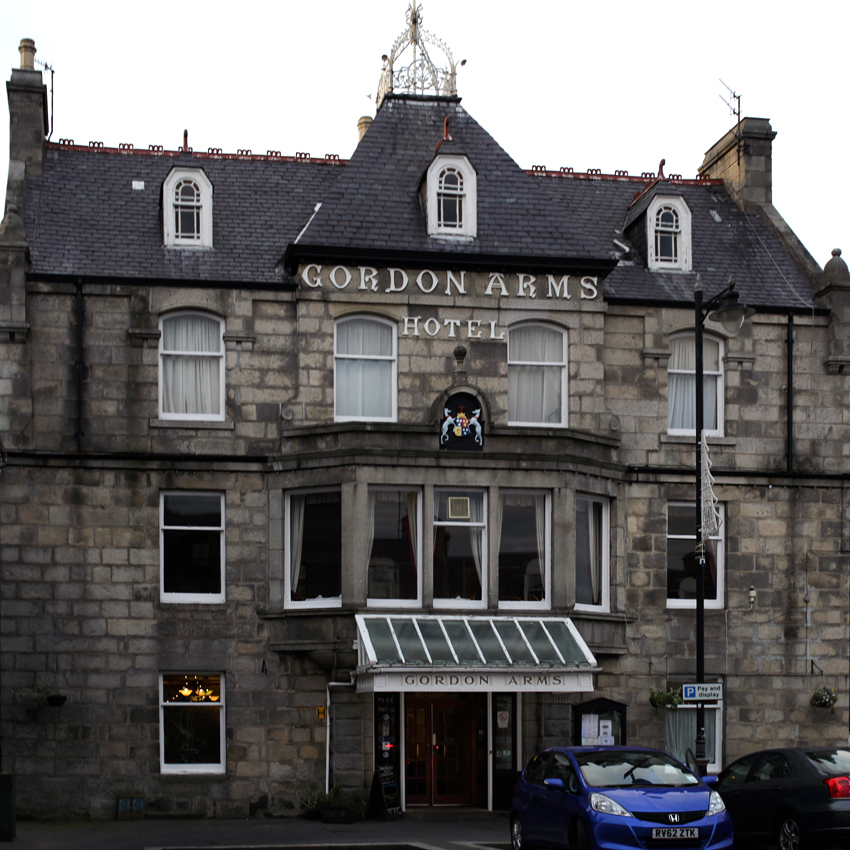 It was another cold and bleak Saturday . . . big clouds, a strong wind, and some blue sky poking through here and there. The days are short this time of year here northeastern Scotland. "Let's take a drive up to Huntly and see the castle this time." "OK." After a beautiful 40 mile drive from Abrdeen, we settled into a delicious lunch in the bar of the Gordon Arms Hotel, Huntly, Aberdeenshire, Scotland.
It was another cold and bleak Saturday . . . big clouds, a strong wind, and some blue sky poking through here and there. The days are short this time of year here northeastern Scotland. "Let's take a drive up to Huntly and see the castle this time." "OK." After a beautiful 40 mile drive from Abrdeen, we settled into a delicious lunch in the bar of the Gordon Arms Hotel, Huntly, Aberdeenshire, Scotland.
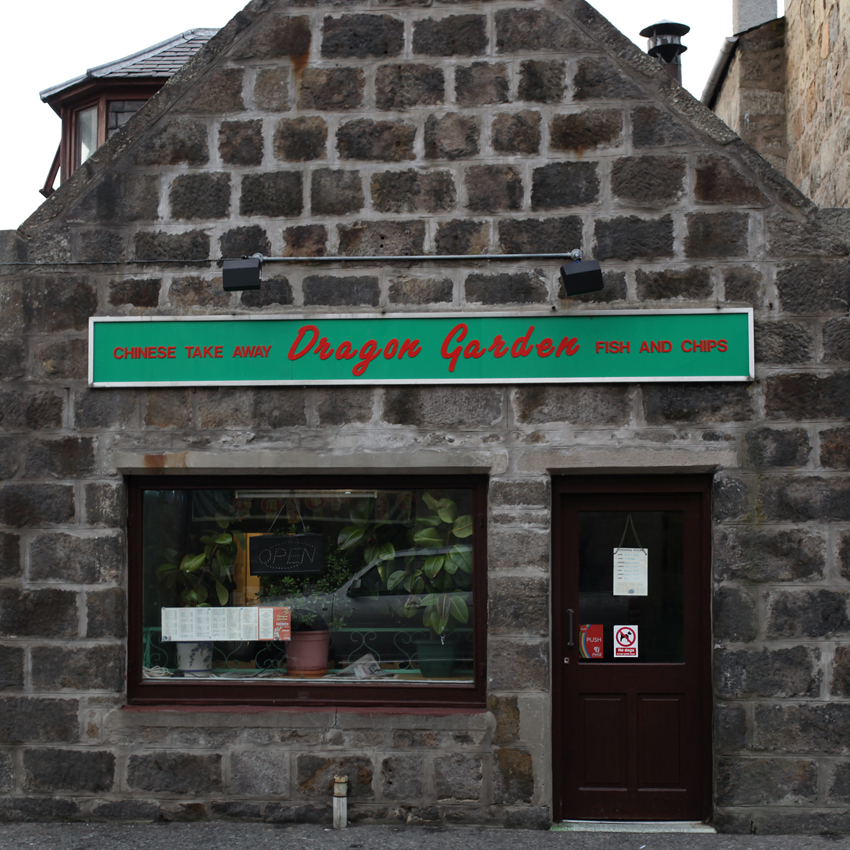 On our walk to Huntly Castle, my wife and I couldn't help but chuckle at this Chinese take-away. Literally every town in Scotland, no matter how big or small, has a Chinese take-away!
On our walk to Huntly Castle, my wife and I couldn't help but chuckle at this Chinese take-away. Literally every town in Scotland, no matter how big or small, has a Chinese take-away!
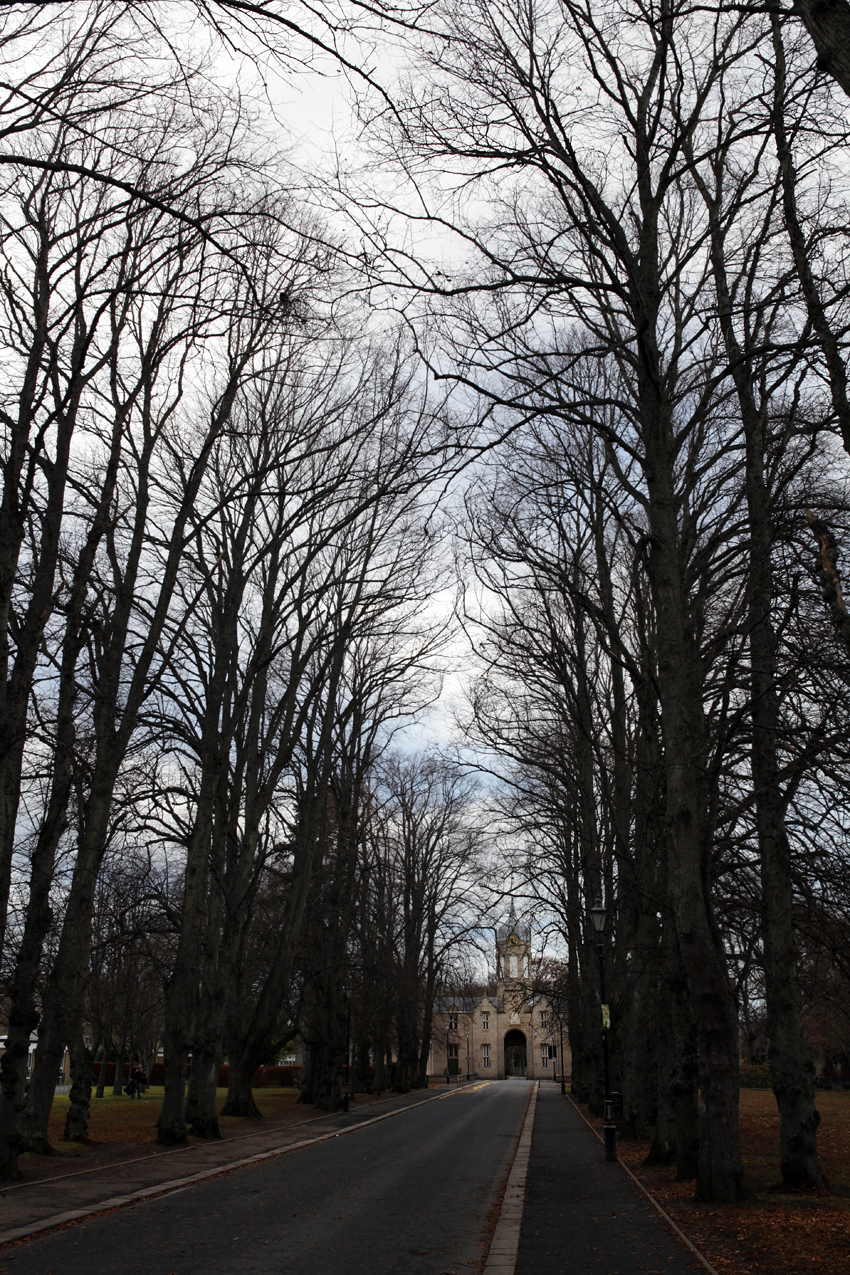 We parked in the city center, and after a delightful lunch in the town square, and walked up the tree lined entry to Huntly Castle.
We parked in the city center, and after a delightful lunch in the town square, and walked up the tree lined entry to Huntly Castle.
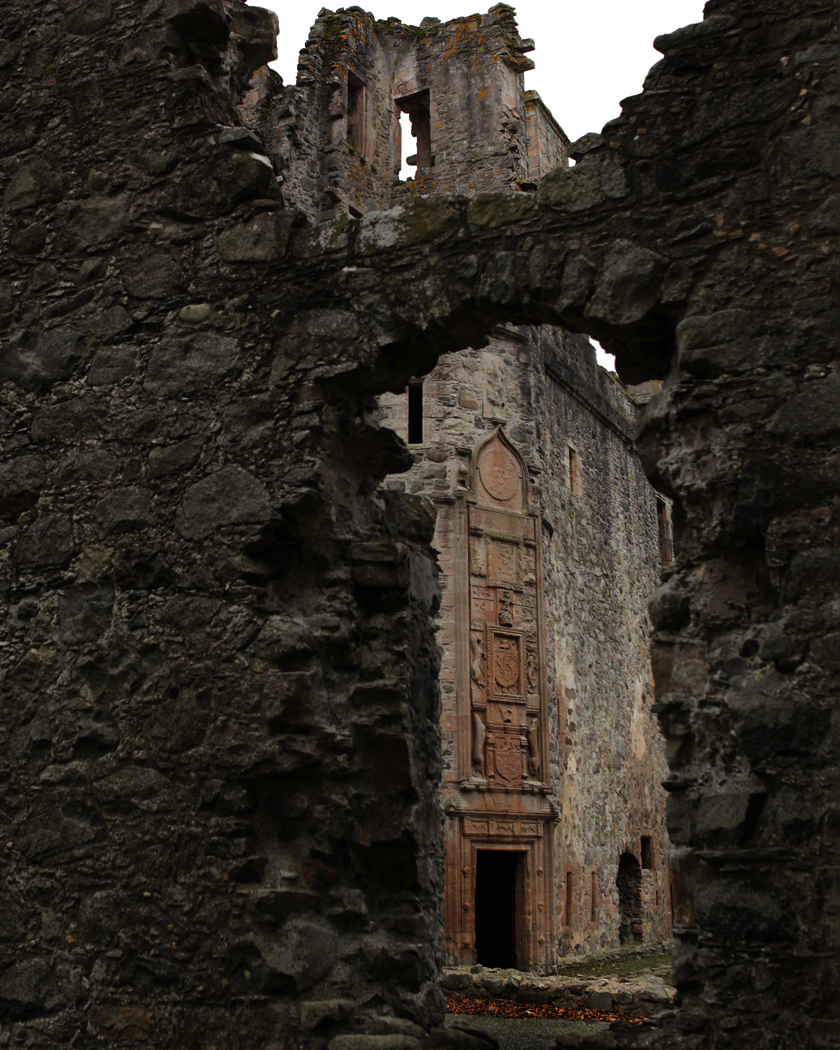 You come up on Huntly Castle from behind old walls . . . and get your first glimpses through the stone framed windows.
You come up on Huntly Castle from behind old walls . . . and get your first glimpses through the stone framed windows.
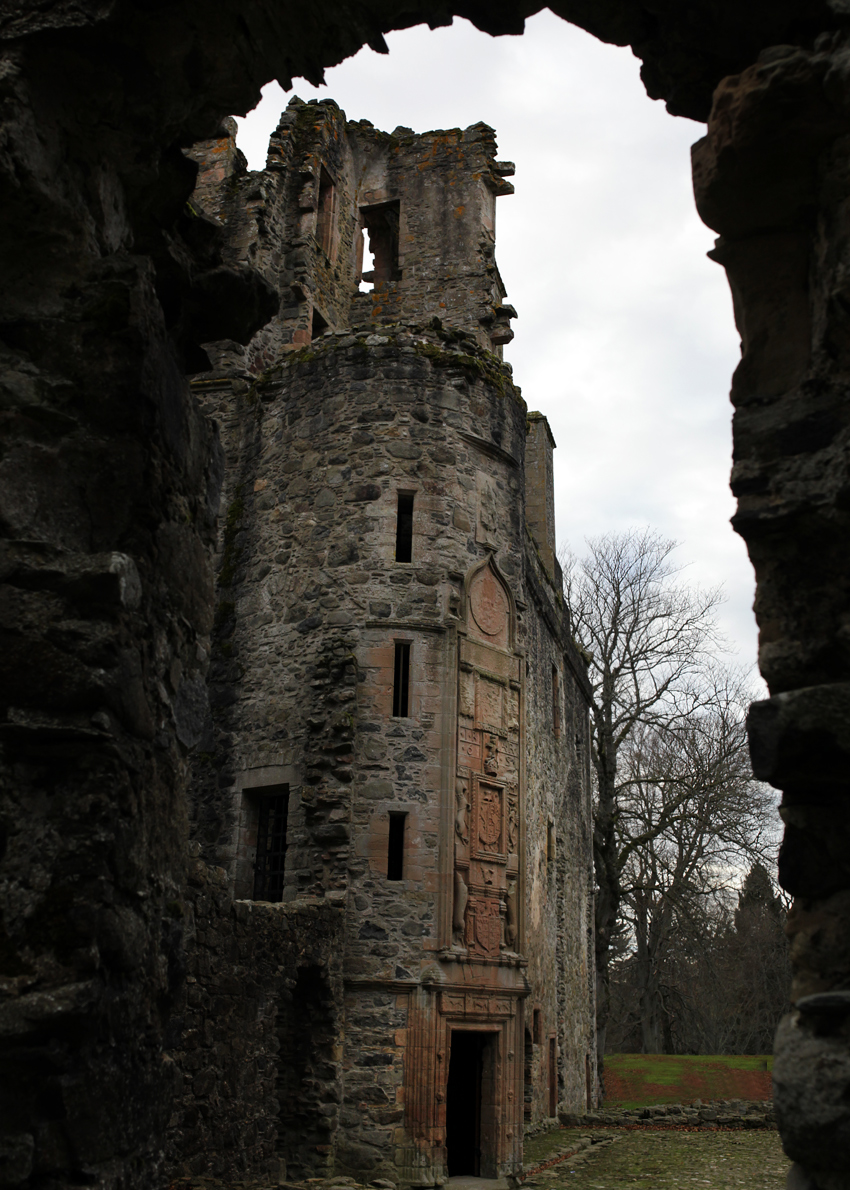 The first castle was built on this spot in the 12th century, but it was torched in 1452. Sometime in the mid-1500s this beautiful structure was built in its place.
The first castle was built on this spot in the 12th century, but it was torched in 1452. Sometime in the mid-1500s this beautiful structure was built in its place.
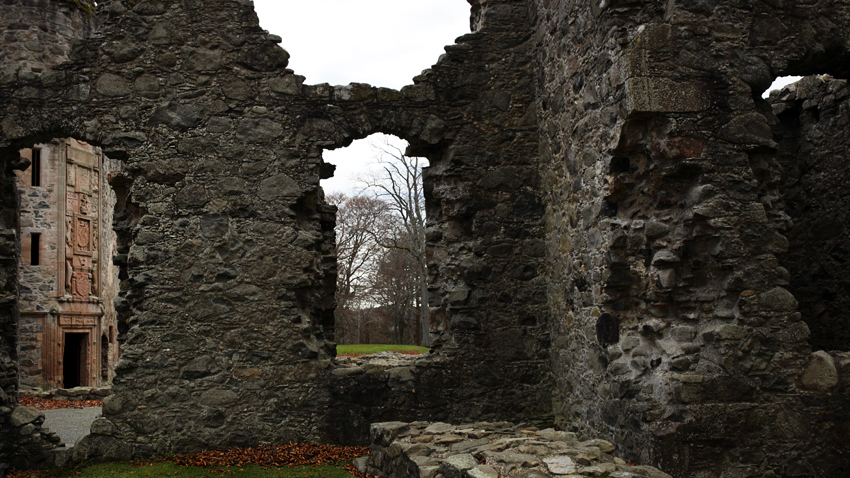 The beautiful and mysterious Huntly Castle ruins.
The beautiful and mysterious Huntly Castle ruins.
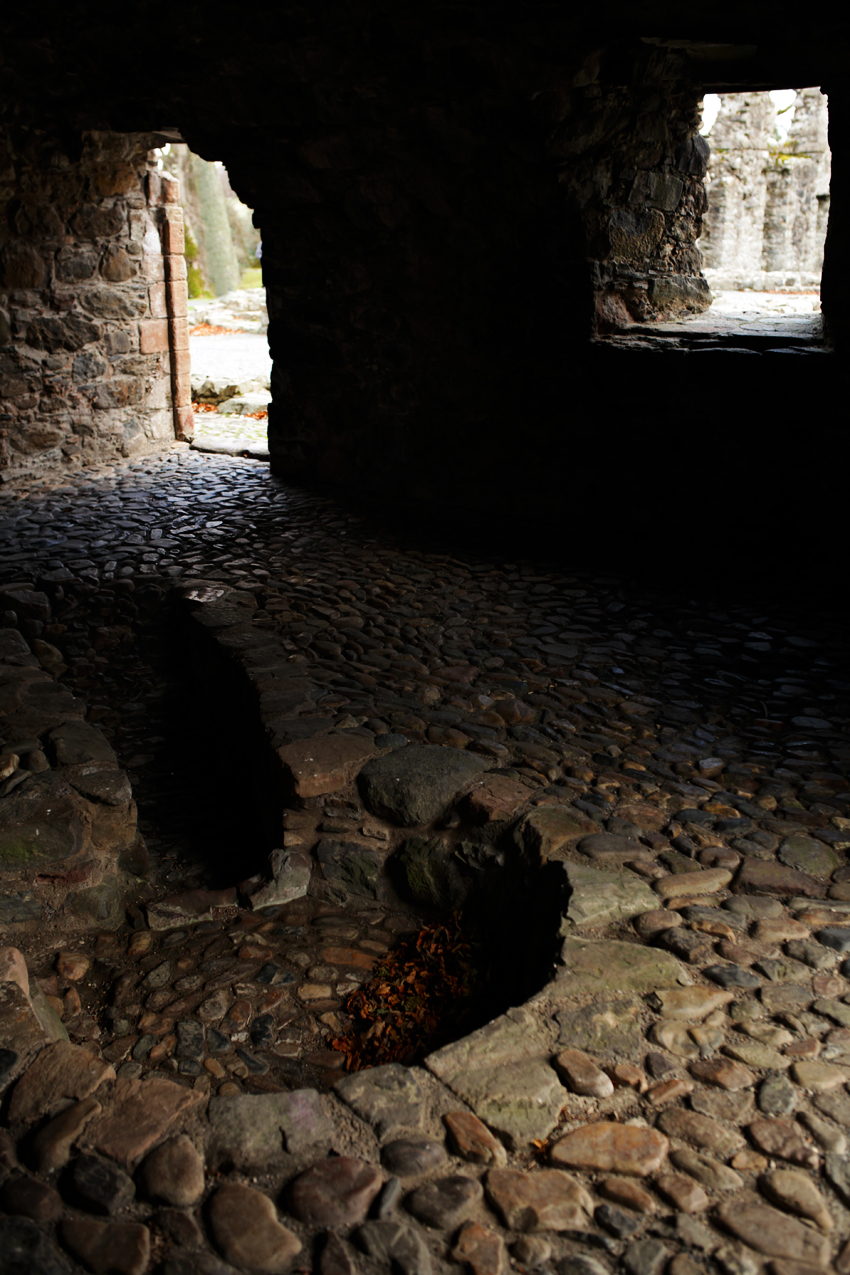 The castle out-buildings held a few surprises: the killing floor of this sheep butchery must have been high technology at the time.
The castle out-buildings held a few surprises: the killing floor of this sheep butchery must have been high technology at the time.
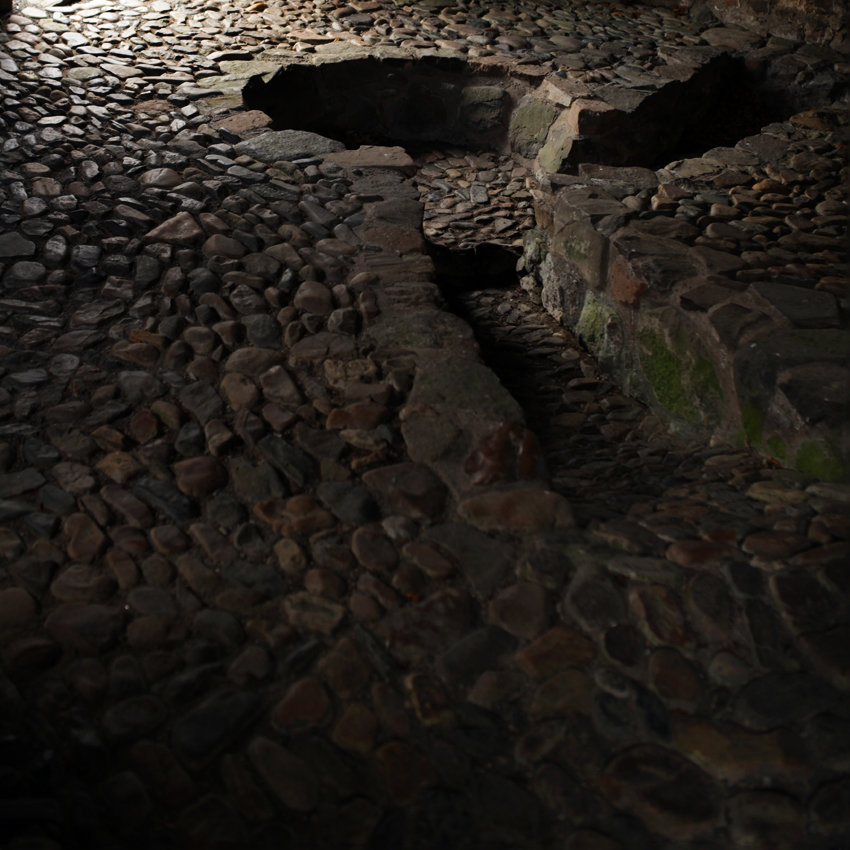 A sign by the Scottish Trust explained that these features were meant to contain sheep entrails and blood . . . haggis catchers!
A sign by the Scottish Trust explained that these features were meant to contain sheep entrails and blood . . . haggis catchers!
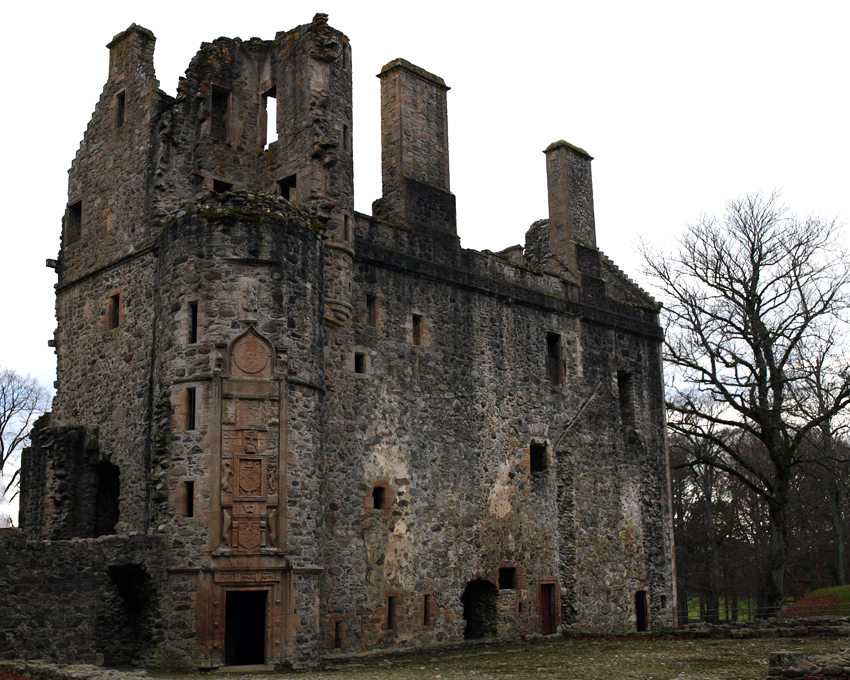 The back, or working, side of Huntly Castle is very imposing on this grey late Autumn day.
The back, or working, side of Huntly Castle is very imposing on this grey late Autumn day.
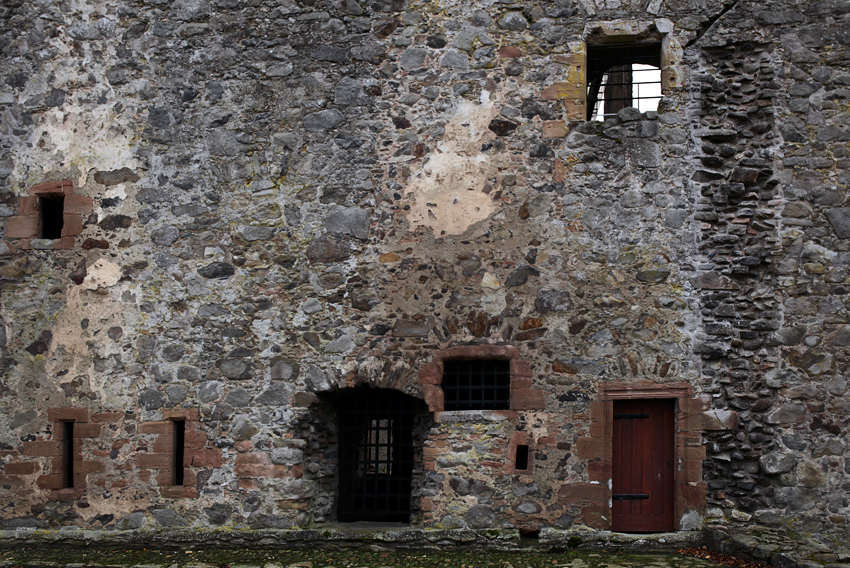 A structural element is missing off the back wall. The 'windows' are purely functional and meet features of the interior without care for the exterior aesthetic consequences . . . as defense is the prime consideration in castle building. My love of 'wall histories' was consummated in full here!
A structural element is missing off the back wall. The 'windows' are purely functional and meet features of the interior without care for the exterior aesthetic consequences . . . as defense is the prime consideration in castle building. My love of 'wall histories' was consummated in full here!
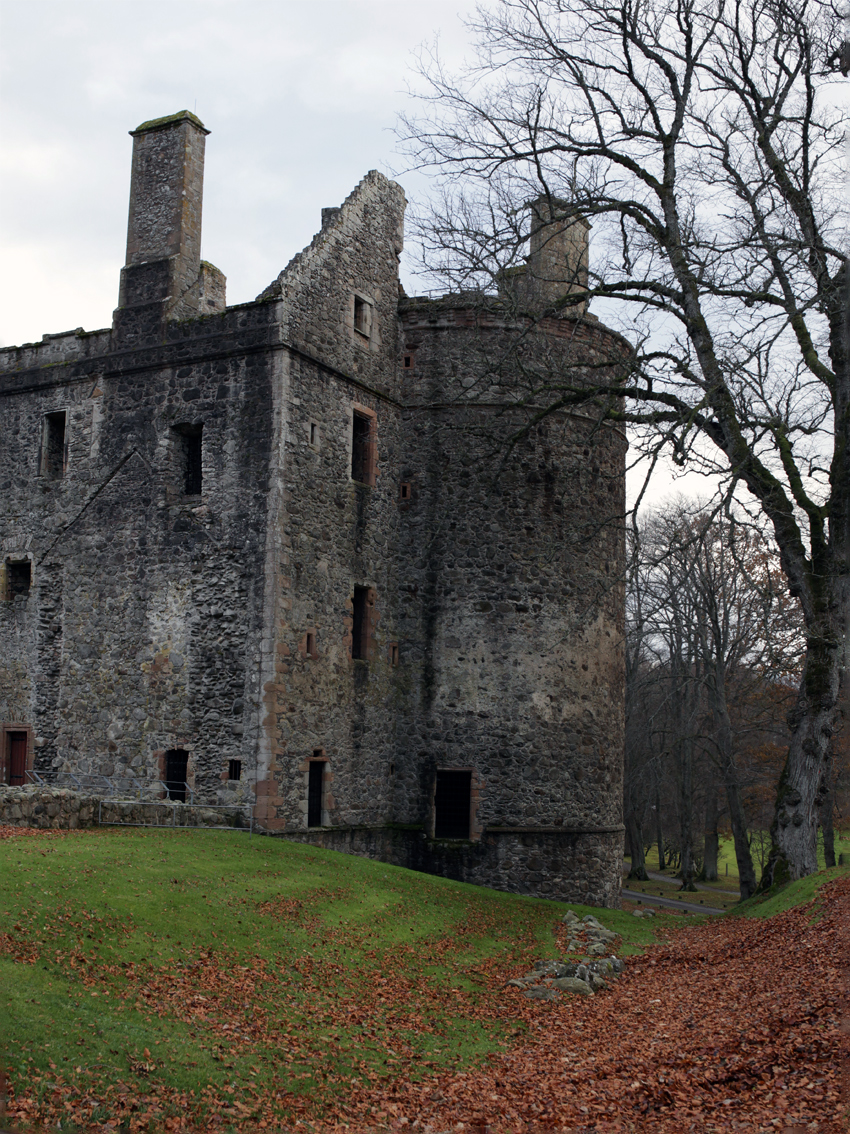 A chilly afternoon at Huntly Castle.
A chilly afternoon at Huntly Castle.
 But it was time to explore the interior of this famous, so called, "haunted" castle.
But it was time to explore the interior of this famous, so called, "haunted" castle.
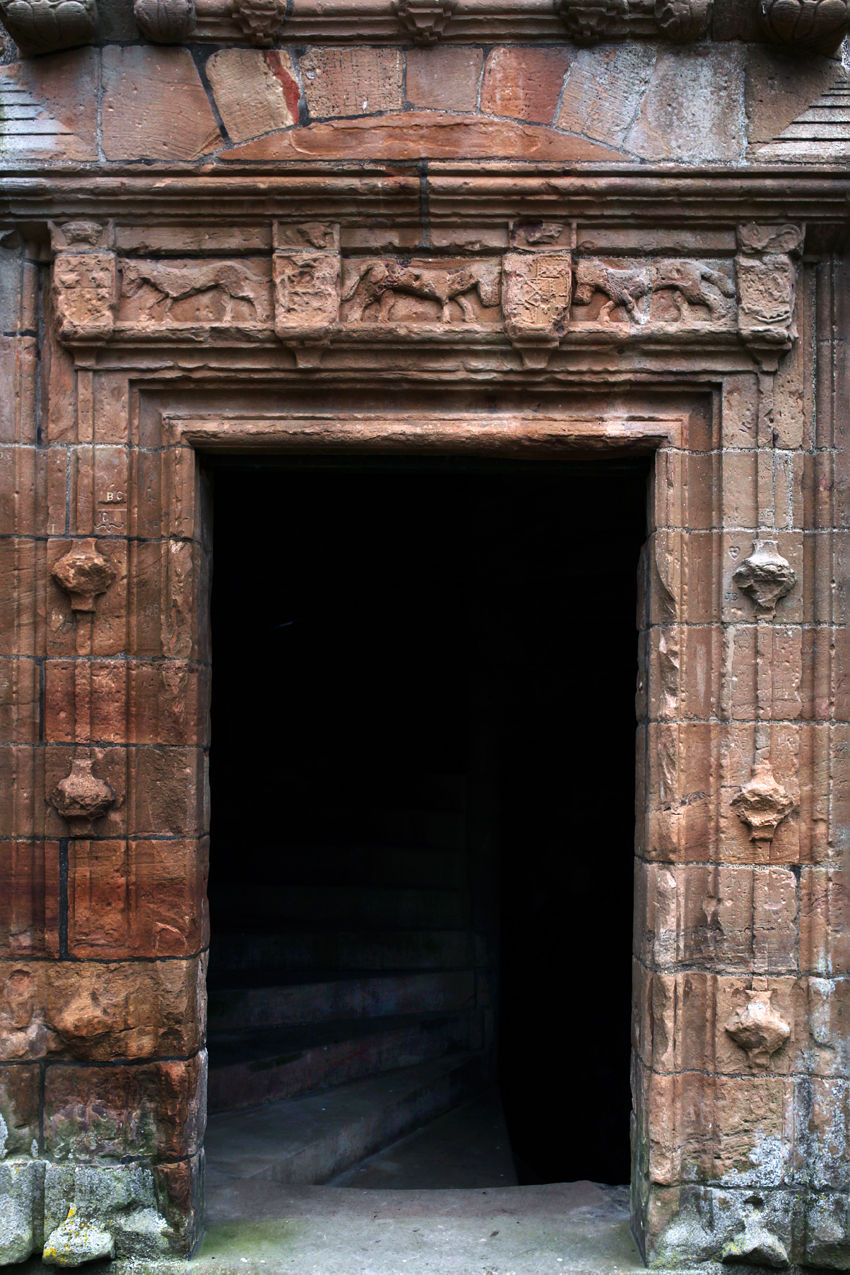 The hunting scenes over the door attest to the castle's past use as a stop-over for royal visitors of the time on hunting trips to the wilderness of Scotland. Robert the Bruce even stayed in the older castle in 1307.
The hunting scenes over the door attest to the castle's past use as a stop-over for royal visitors of the time on hunting trips to the wilderness of Scotland. Robert the Bruce even stayed in the older castle in 1307.
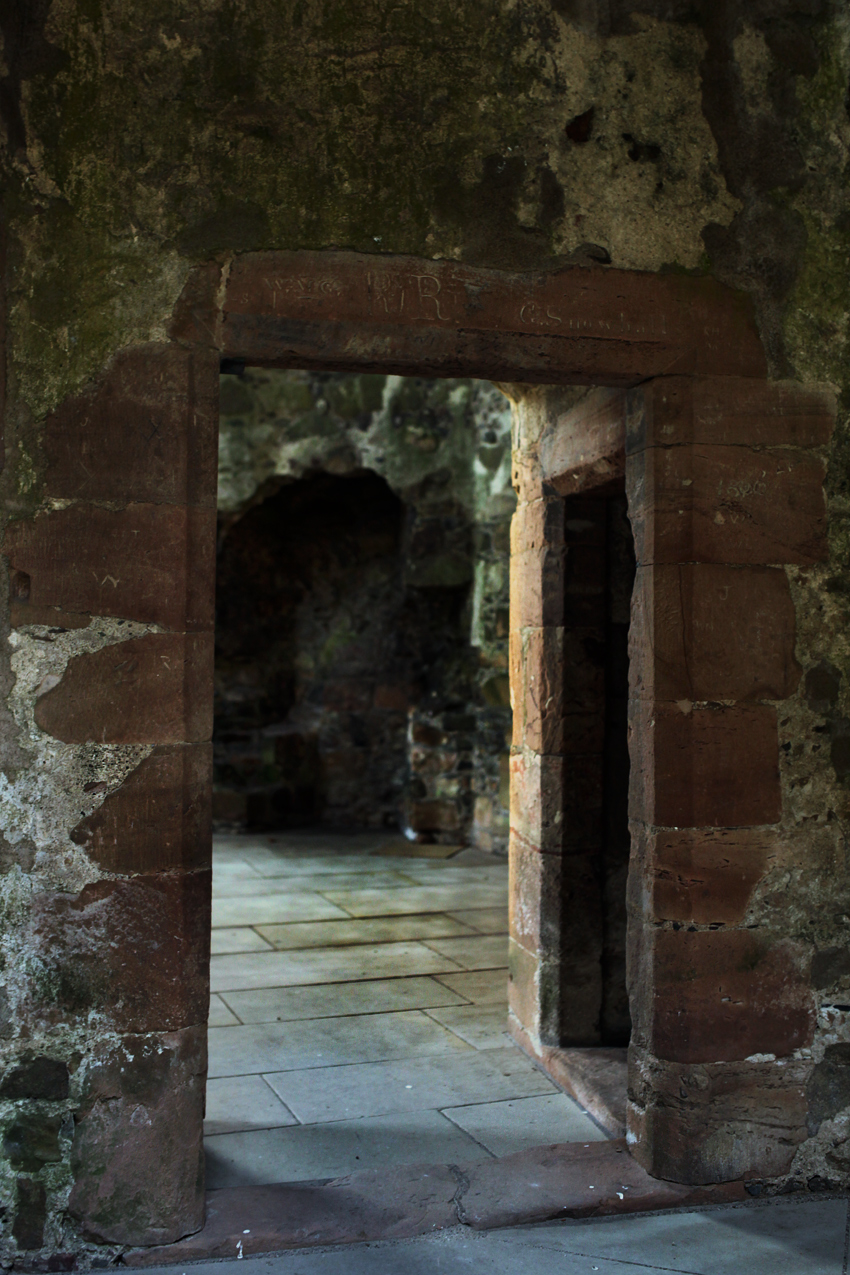 The interior was empty and parts of the roof were open to the sky.
The interior was empty and parts of the roof were open to the sky.
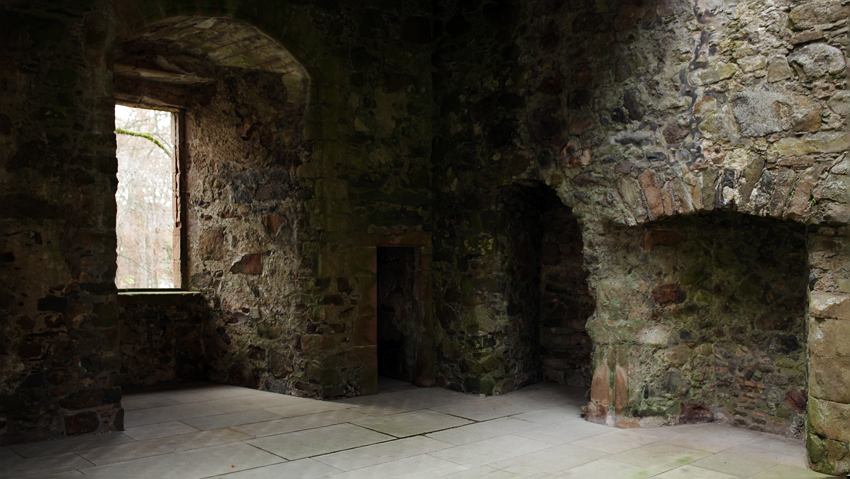 The castle was completely abandoned by the 18th century . . . and all the interior decor and features have long since been stripped. The Scottish National Trust seems to have been responsible for installing the flooring on the second level and the improvised structural bracing seen here and there.
The castle was completely abandoned by the 18th century . . . and all the interior decor and features have long since been stripped. The Scottish National Trust seems to have been responsible for installing the flooring on the second level and the improvised structural bracing seen here and there.
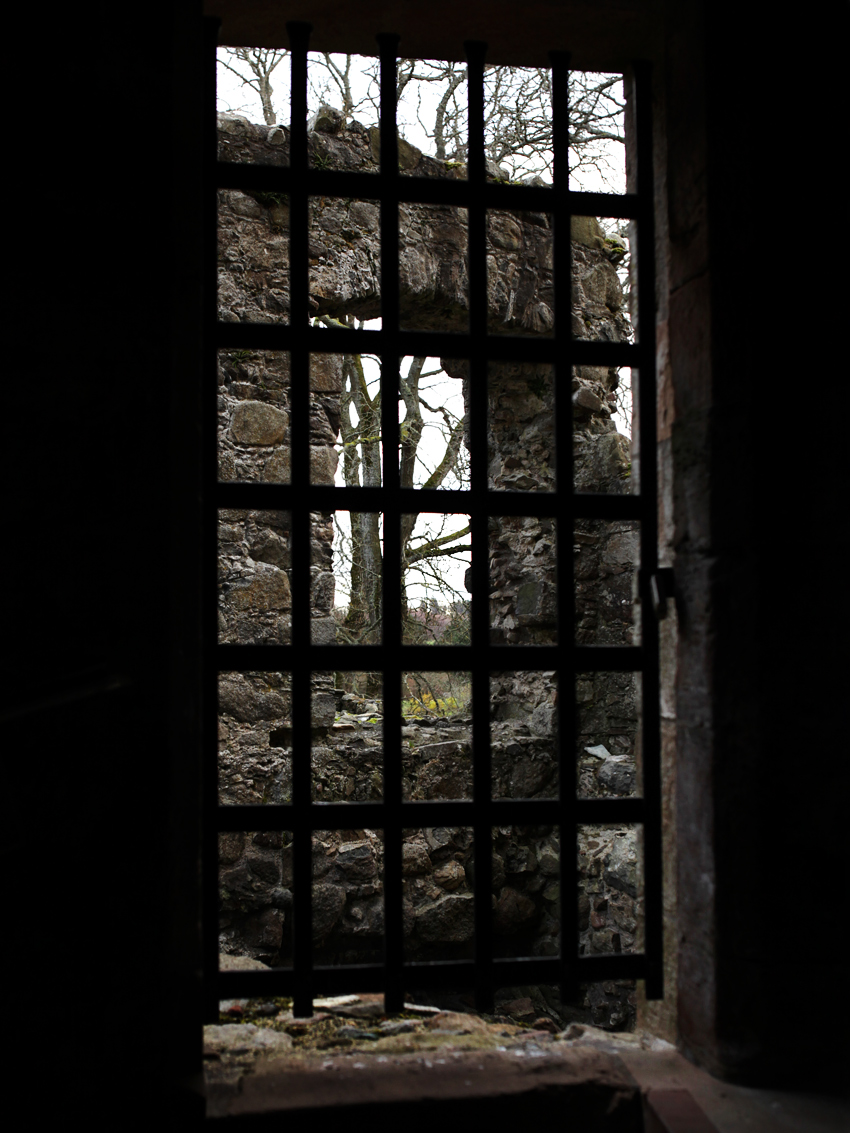 A window view out on the gloomy day. The sun never rises very far into the sky this time of year, but it goes down very slowly which extends the sunsets for a long time.
A window view out on the gloomy day. The sun never rises very far into the sky this time of year, but it goes down very slowly which extends the sunsets for a long time.
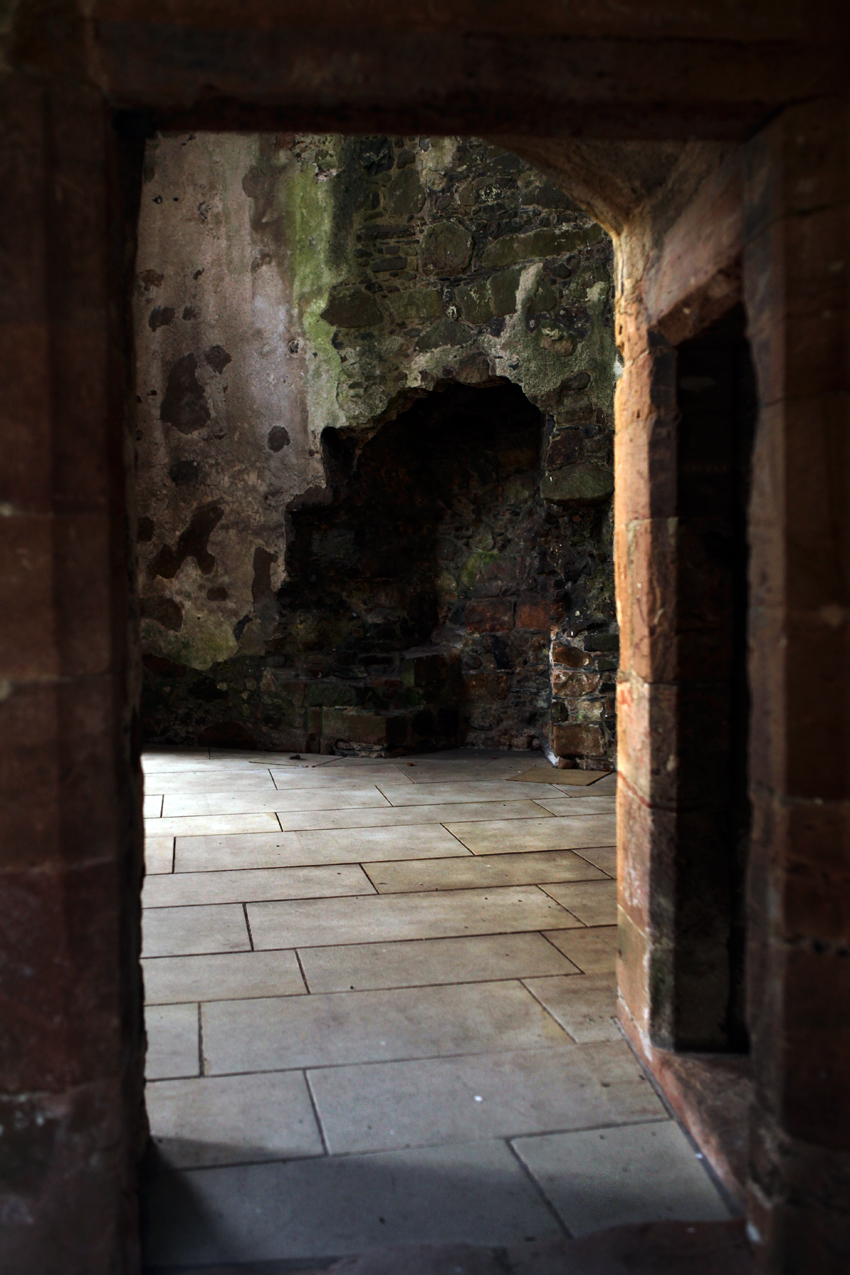 As I made my way over to the rooms on the south side, the light became fantastic.
As I made my way over to the rooms on the south side, the light became fantastic.
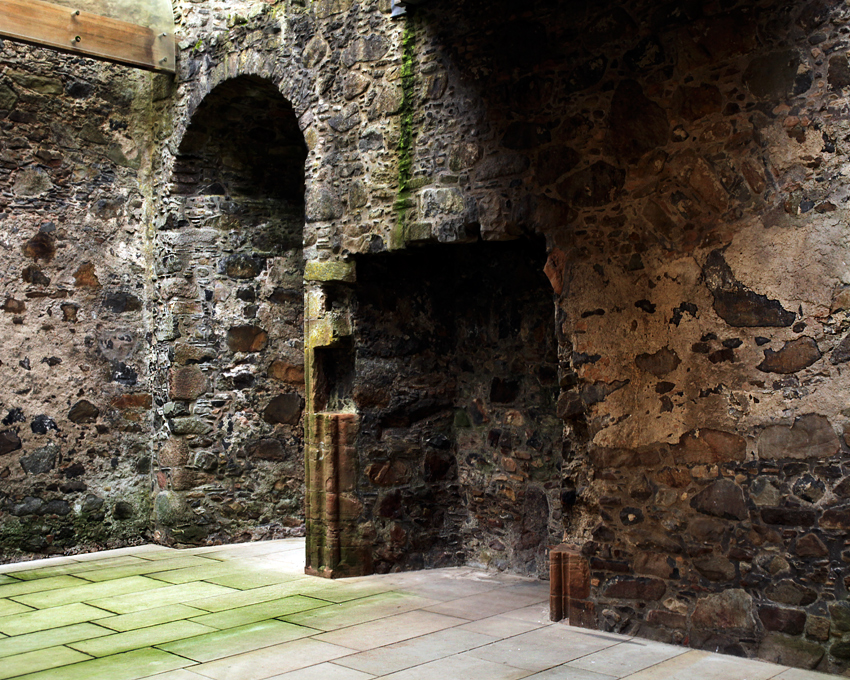 You can see the structural bracing in the yummie light and shadow . . . I'll try it in Black and White . . . .
You can see the structural bracing in the yummie light and shadow . . . I'll try it in Black and White . . . .
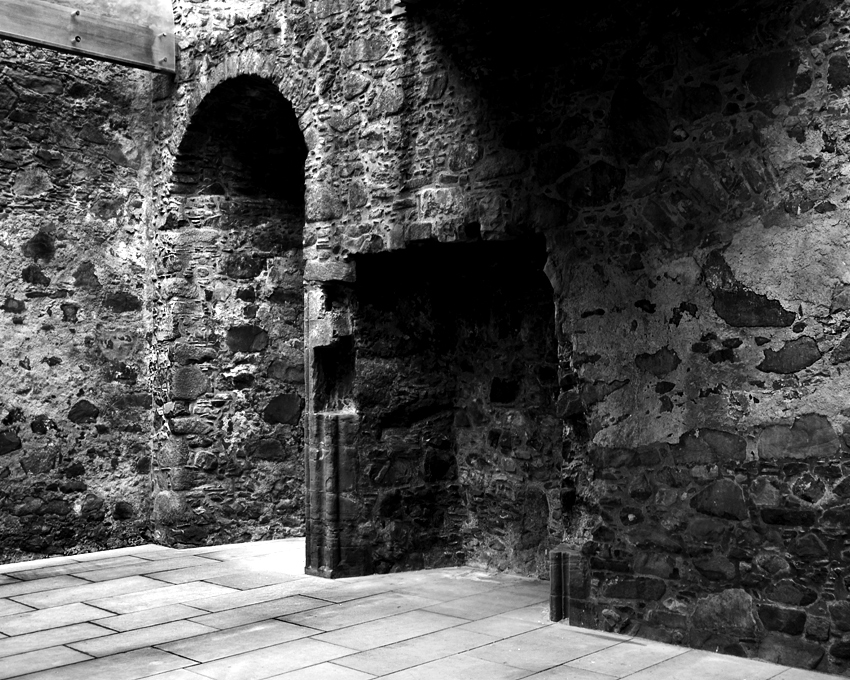 Oh yes.
Oh yes.
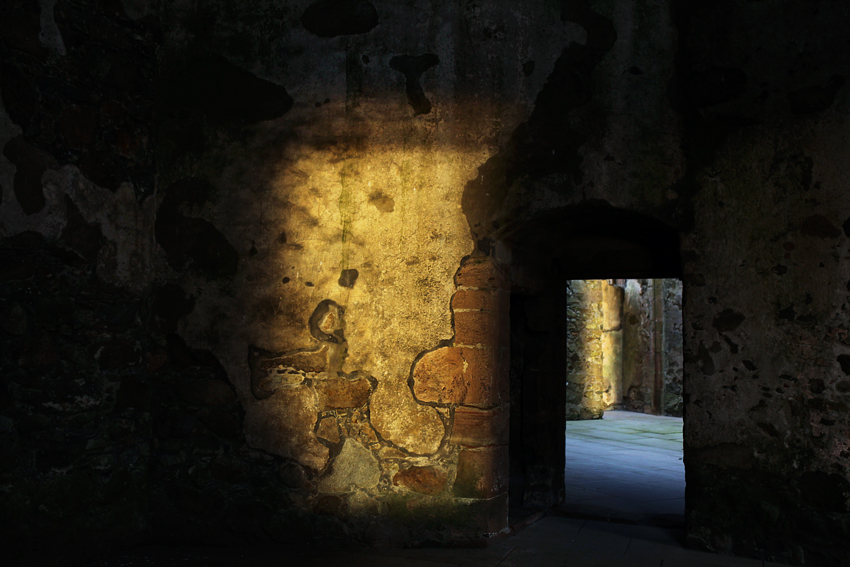 The sun at last sunk beneath the low cloud cover to shine a golden light through the windows of Huntly Castle!
The sun at last sunk beneath the low cloud cover to shine a golden light through the windows of Huntly Castle!
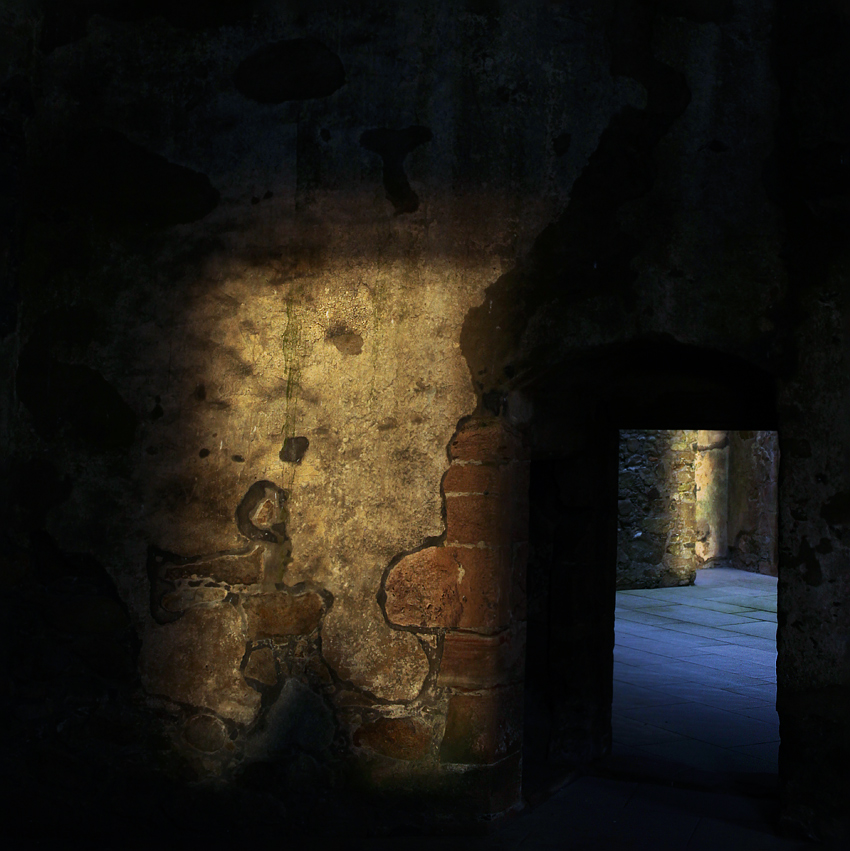 Oh! The light!
Oh! The light!
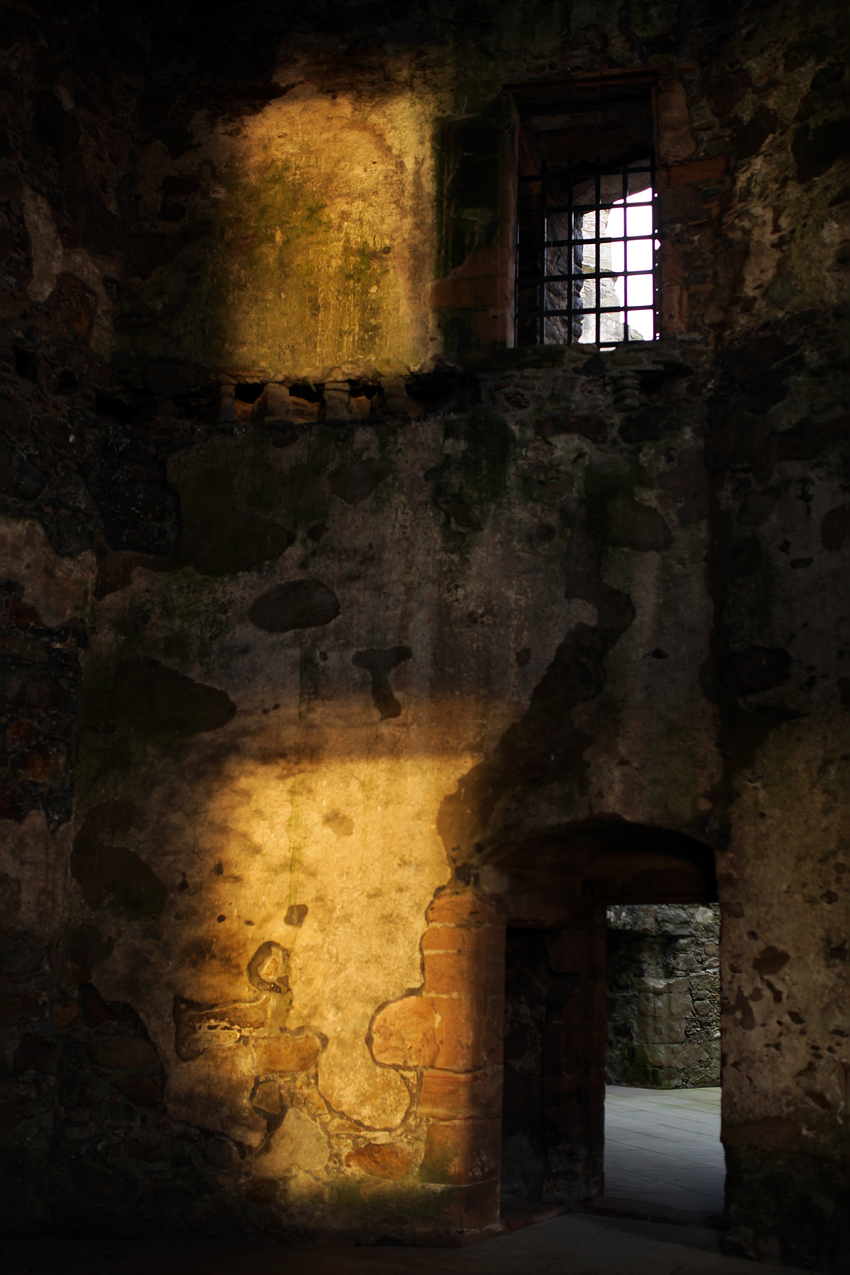 I realized I was standing in the castle tower, and looking up I was surprised to see the high walls lit with golden light.
I realized I was standing in the castle tower, and looking up I was surprised to see the high walls lit with golden light.
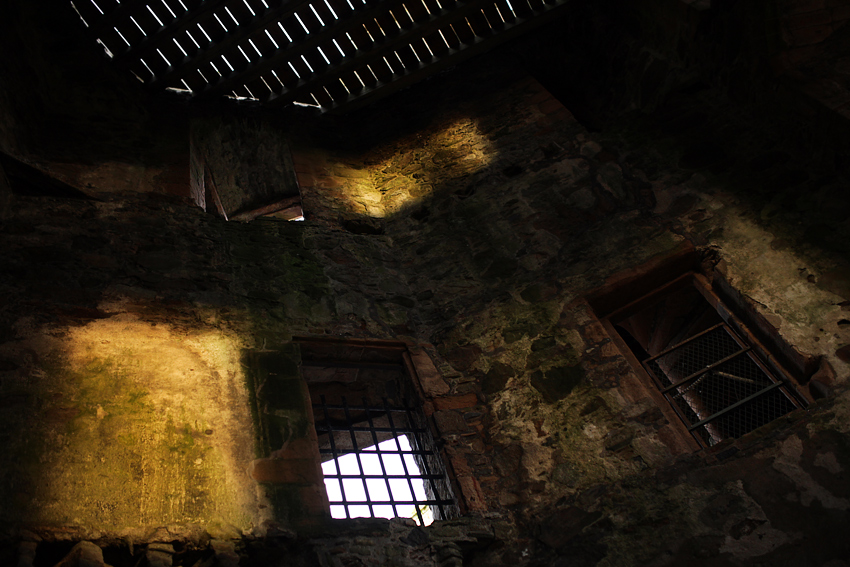 An otherworldly sight! The castle tower lit from the inside!
An otherworldly sight! The castle tower lit from the inside!
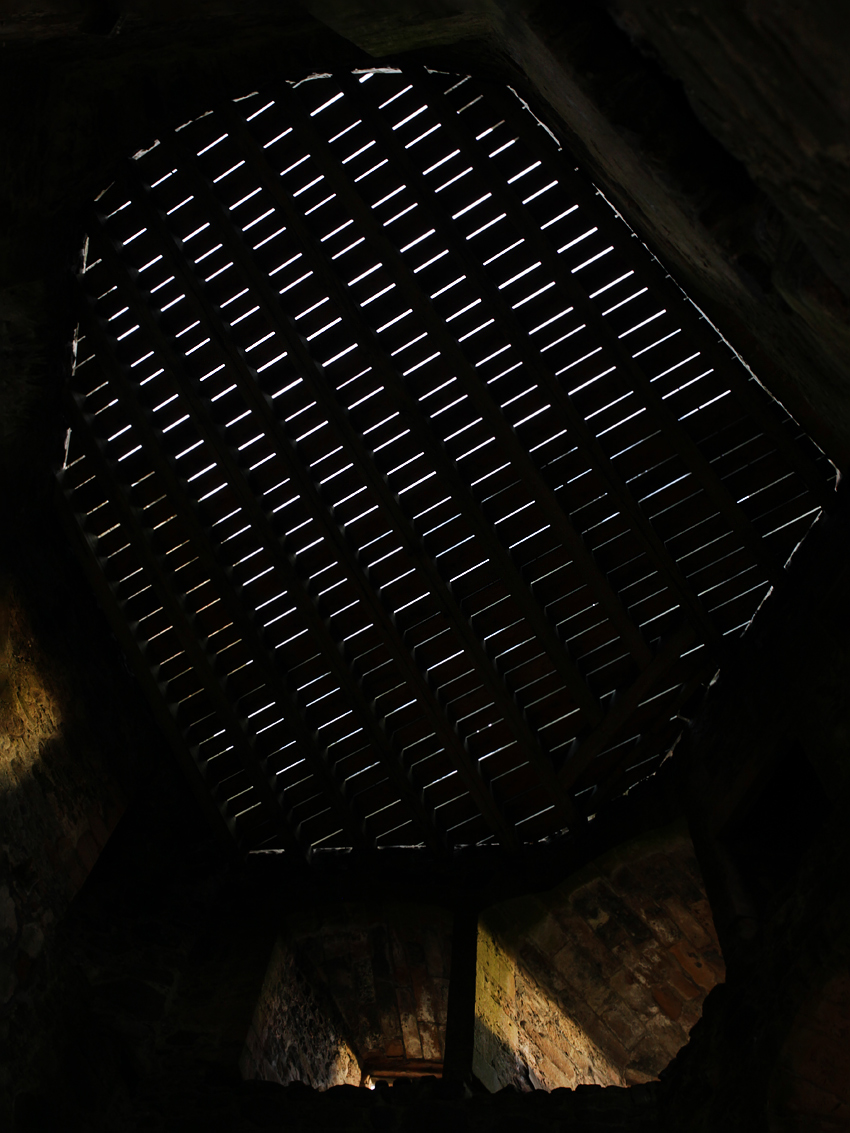 The recreated slotted ceiling lattice and fine light.
The recreated slotted ceiling lattice and fine light.
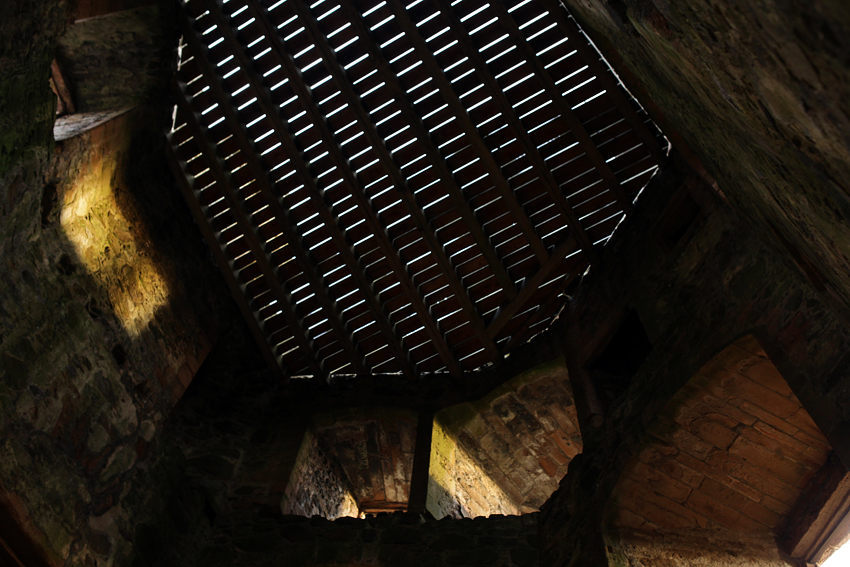 Perhaps one of the best photos I have ever taken . . . the only thing missing is a body in a noose hanging from the high castle tower ceiling. Too bad I didn't have my 16-35 L-II lens with me.
Perhaps one of the best photos I have ever taken . . . the only thing missing is a body in a noose hanging from the high castle tower ceiling. Too bad I didn't have my 16-35 L-II lens with me.
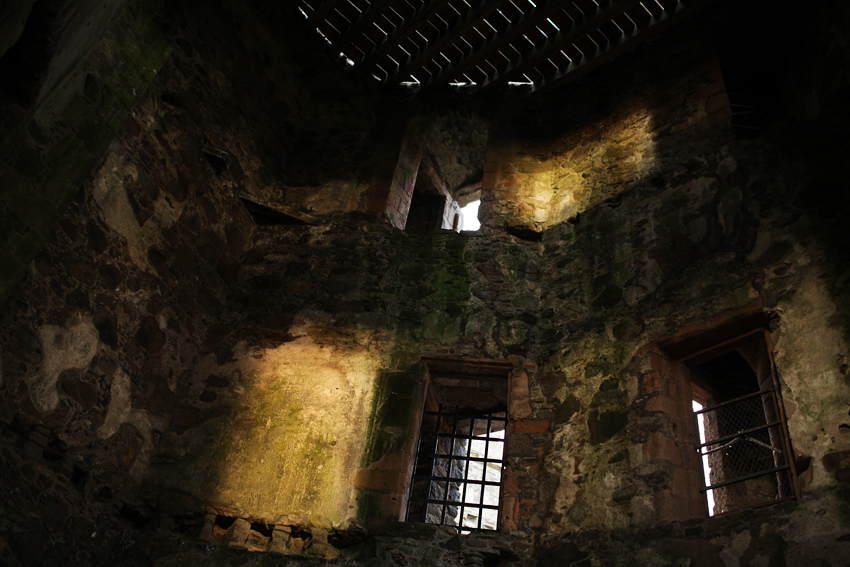 A marvelous, cold, quiet space.
A marvelous, cold, quiet space.
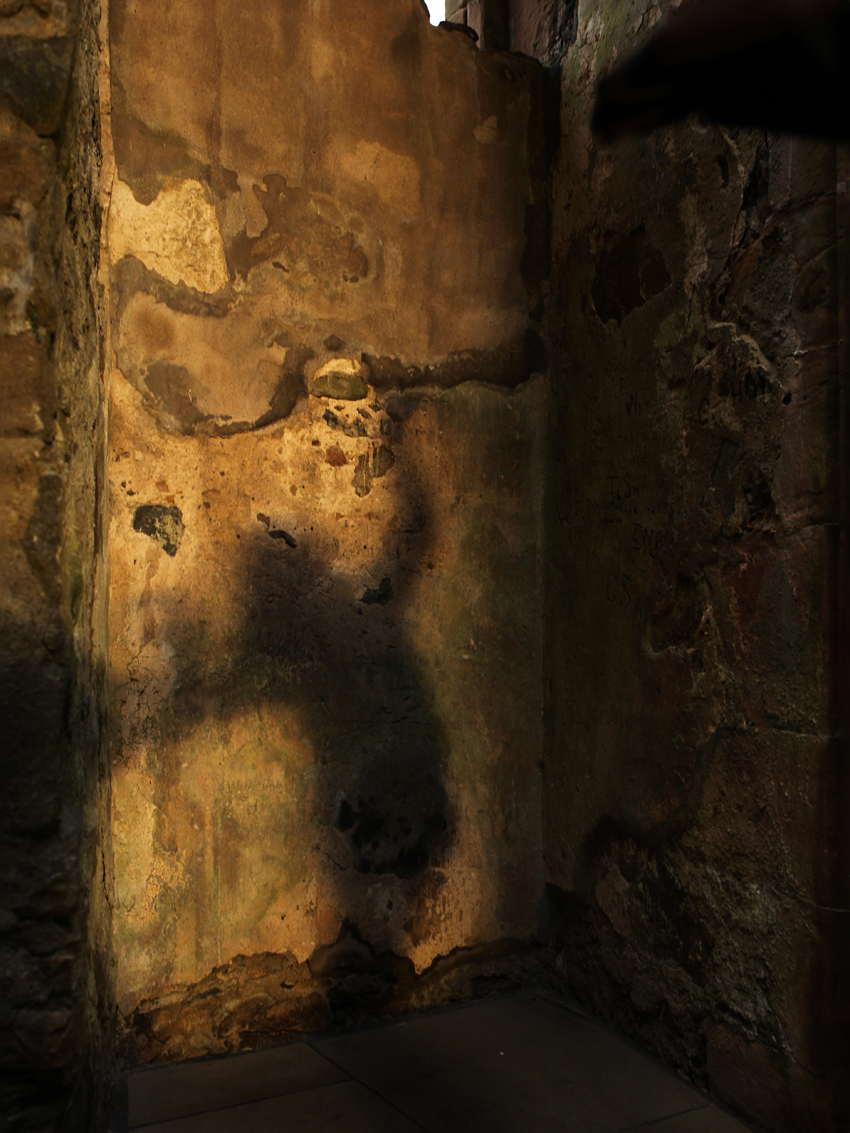 There are many stories of ghosts in Huntly Castle lore. This happens not to be one of them . . . it's my wife's dancing shadow.
There are many stories of ghosts in Huntly Castle lore. This happens not to be one of them . . . it's my wife's dancing shadow.
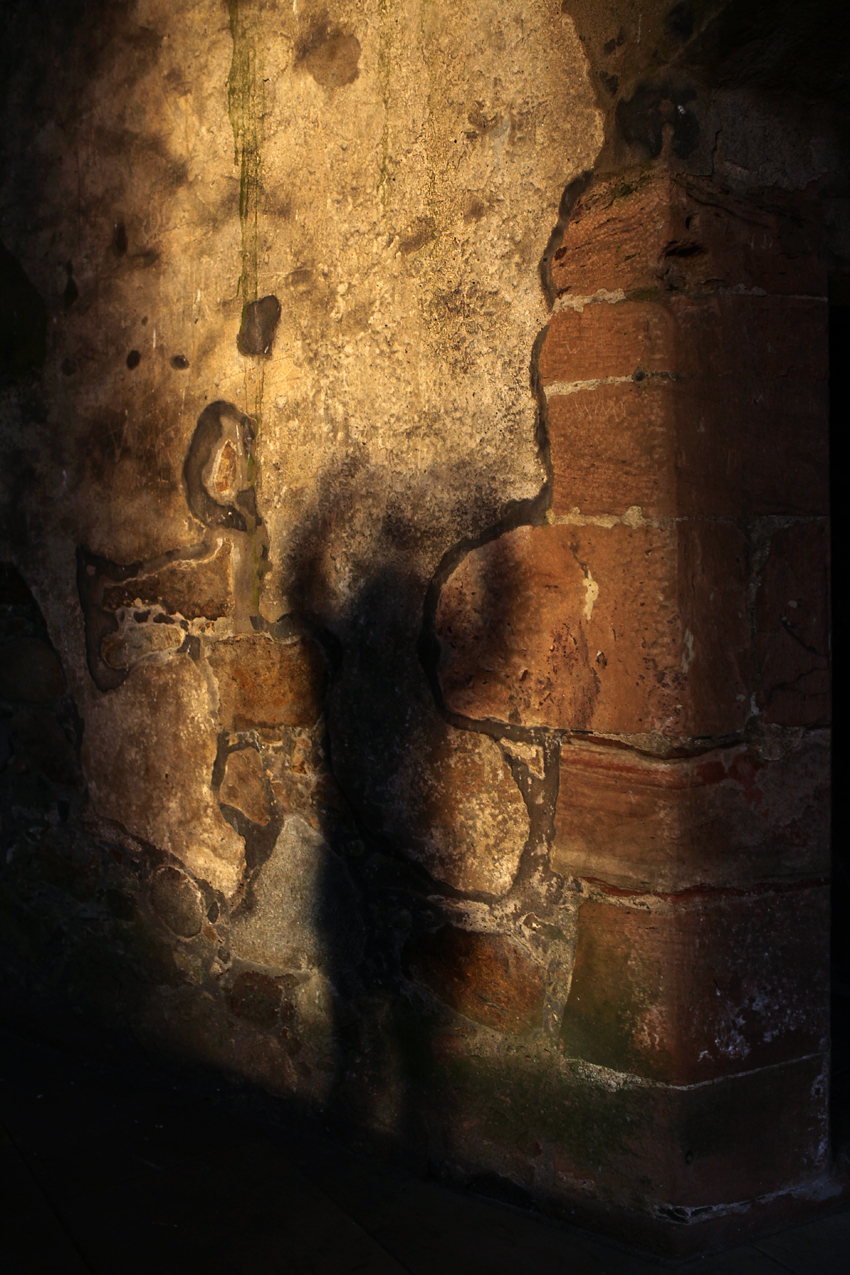 Castle shadow ballerina.
Castle shadow ballerina.
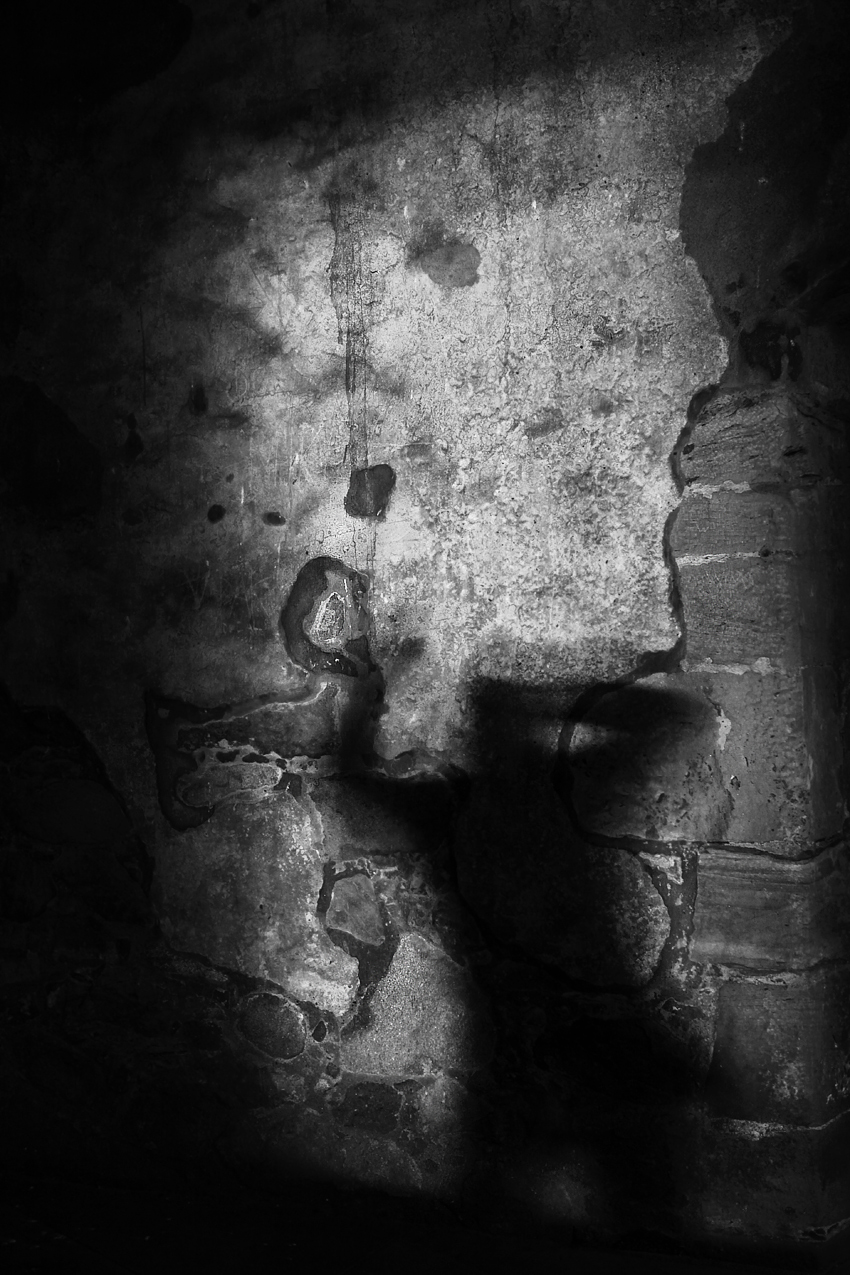 Self Portrait With Wall no.24. I'm a shadow of my former self.
Self Portrait With Wall no.24. I'm a shadow of my former self.
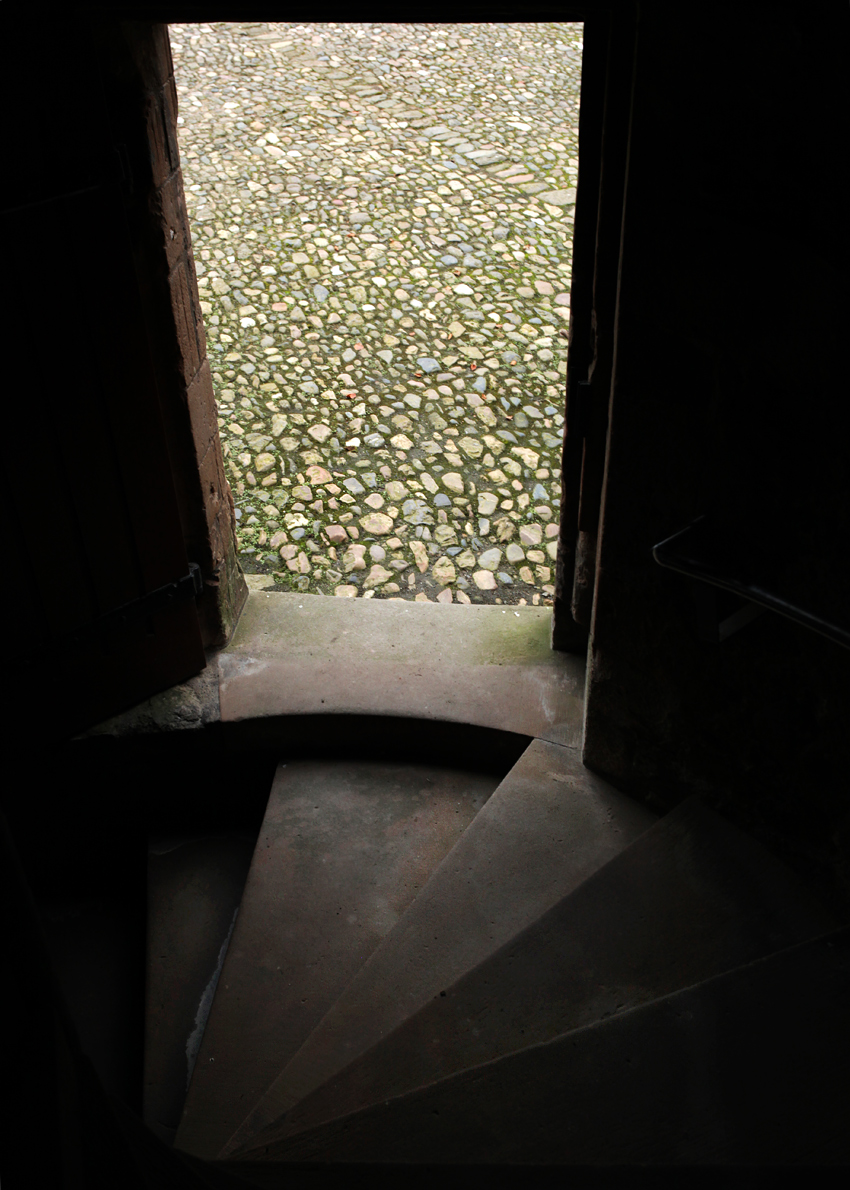 All good things must come to an end . . . time to leave Huntly Castle. It gets dark early, and we have a 40 mile drive ahead of us.
All good things must come to an end . . . time to leave Huntly Castle. It gets dark early, and we have a 40 mile drive ahead of us.
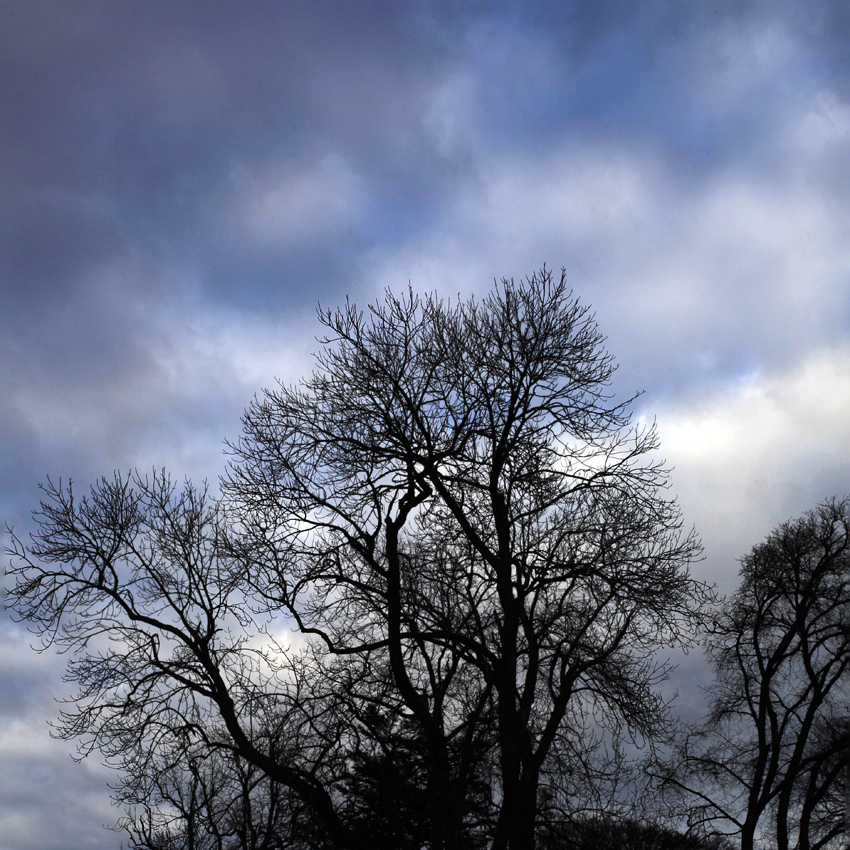 I was met with this skyview as soon as I stepped out of the castle door.
I was met with this skyview as soon as I stepped out of the castle door.
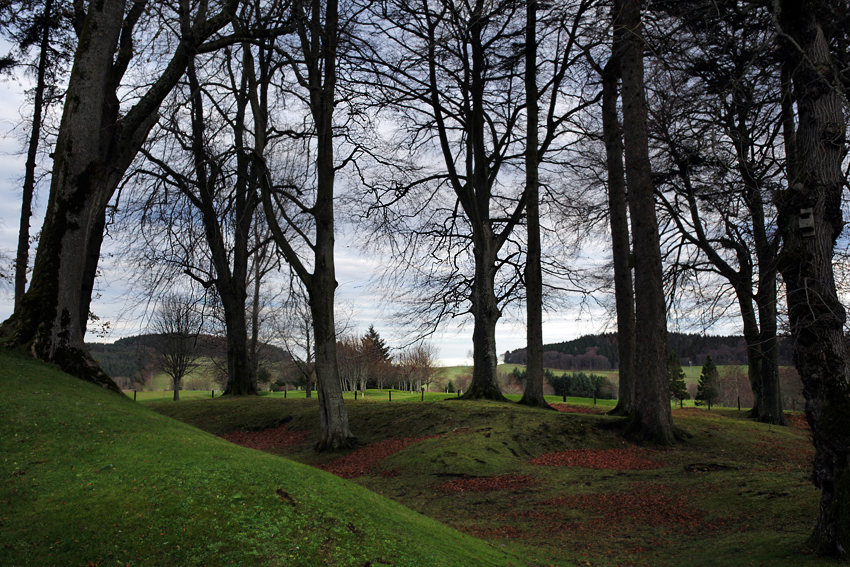 The Aberdeenshire countryside around the castle was delightful.
The Aberdeenshire countryside around the castle was delightful.
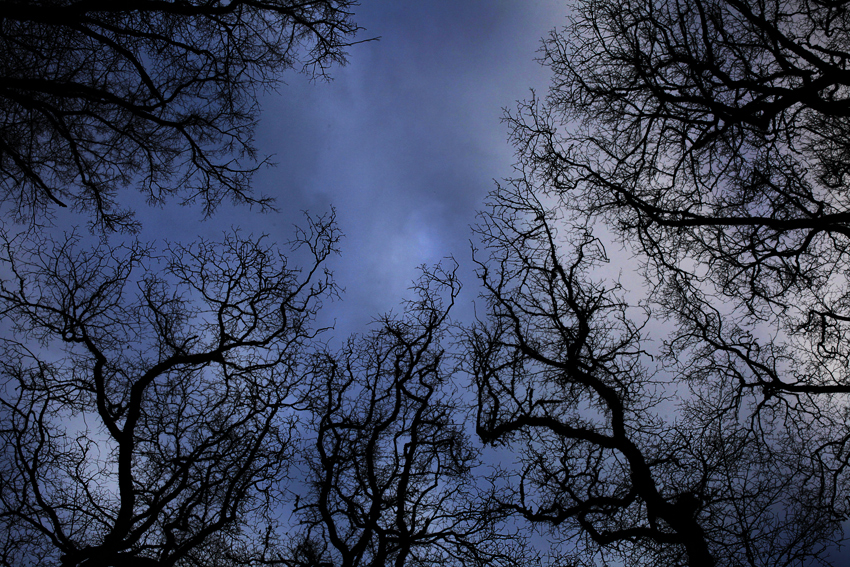 The preferred view was straight up into the Autumn Scottish sky.
The preferred view was straight up into the Autumn Scottish sky.
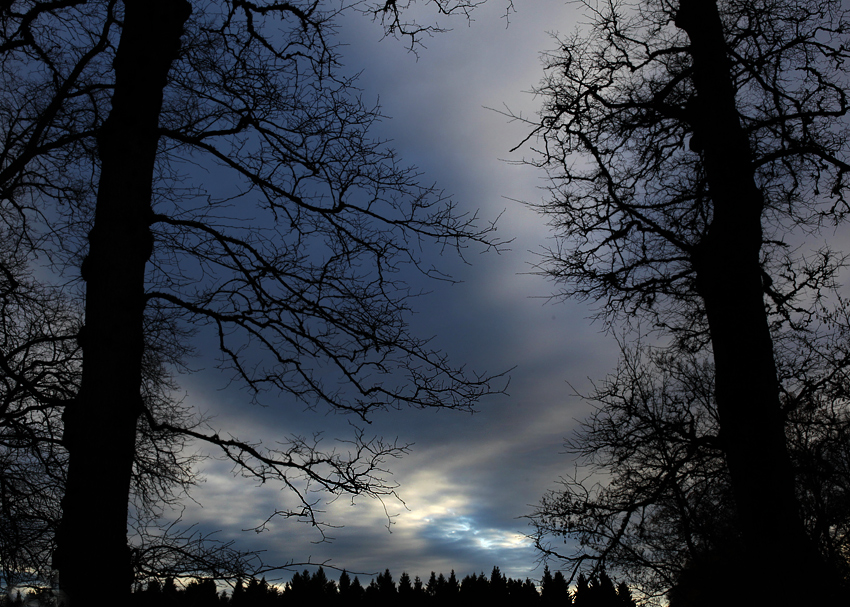 The sun is always low in the sky in this part of Scotland at this time of year. Wonderful moods on the day.
The sun is always low in the sky in this part of Scotland at this time of year. Wonderful moods on the day.
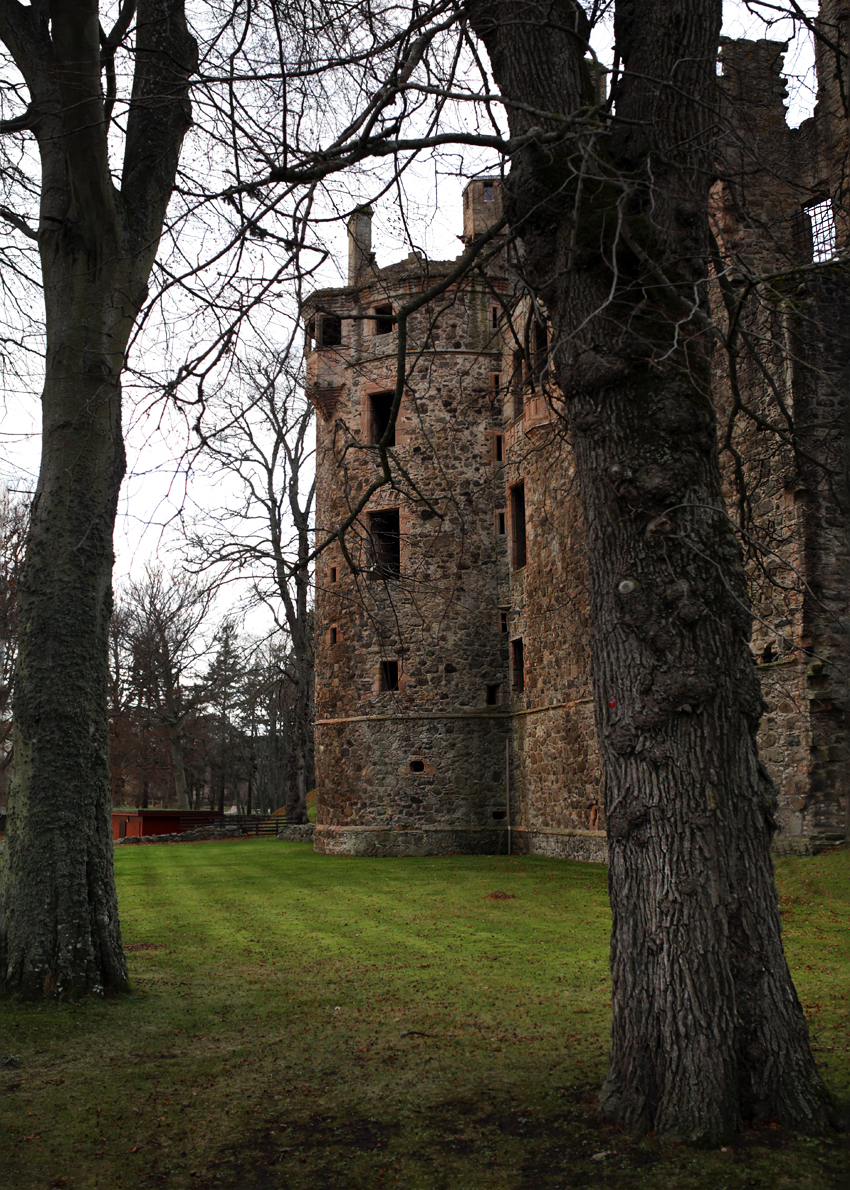 We passed around the front of Huntly Castle on our way out.
We passed around the front of Huntly Castle on our way out.
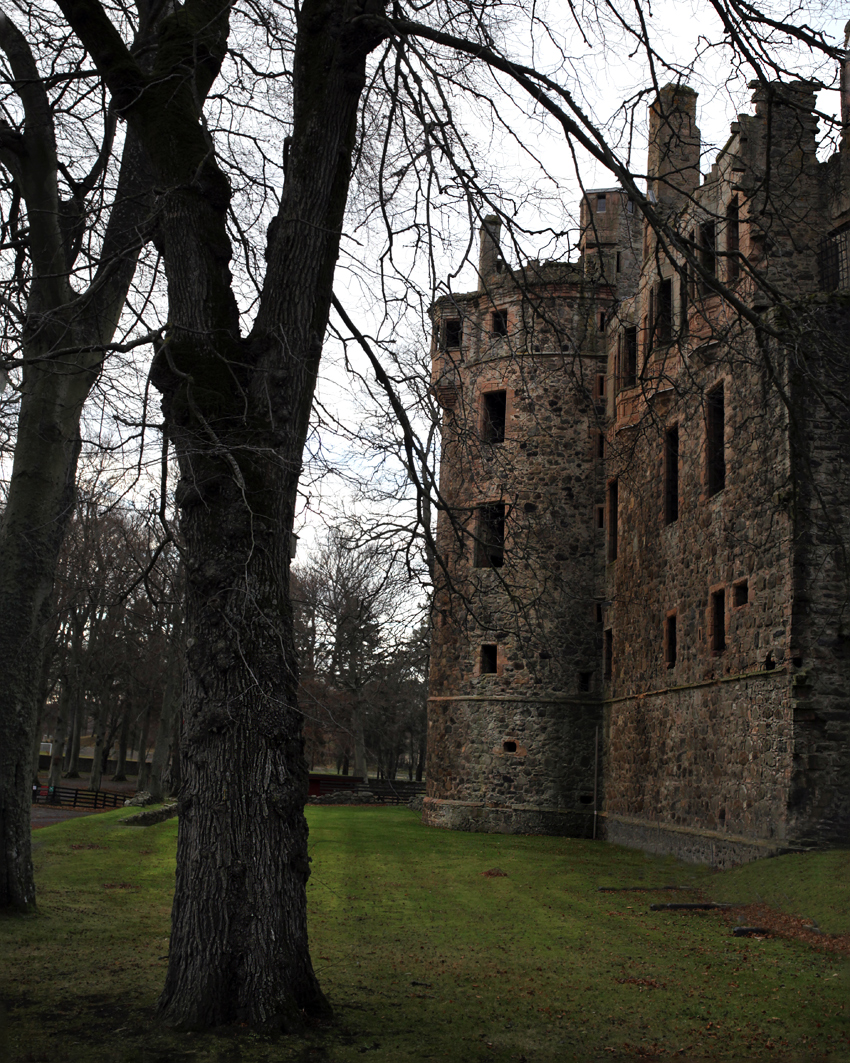 What an imposing structure it must have been in its day.
What an imposing structure it must have been in its day.
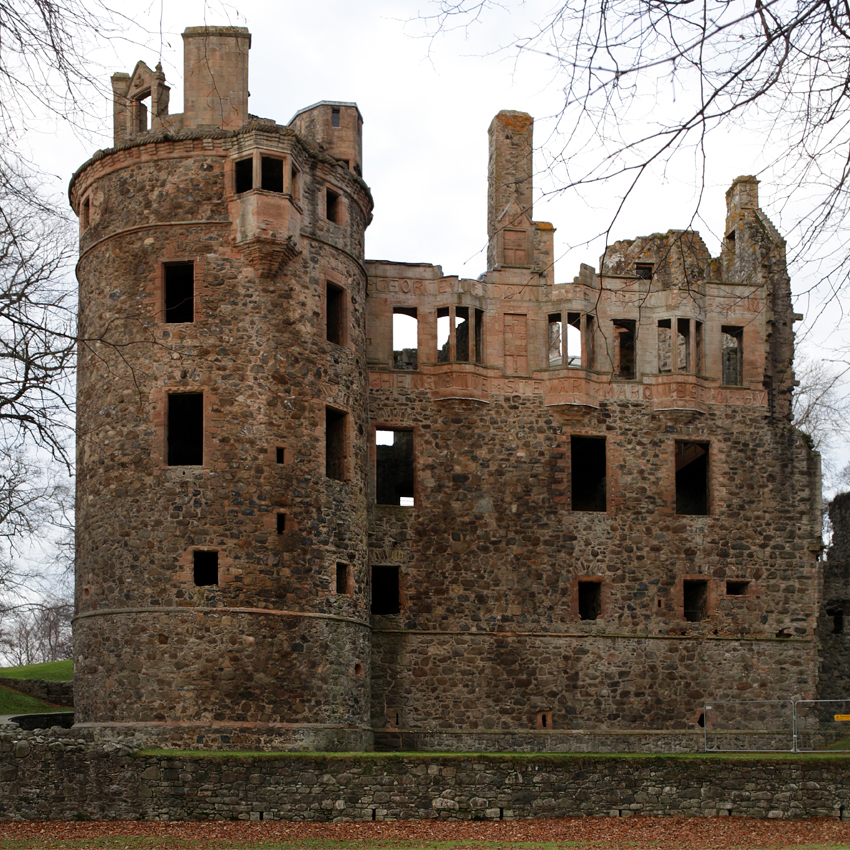 Huntly Castle ruins in their full splendor. The golden light of only moments earlier had gone. I looked up at the tower and was glad I was lucky enough to be there at the right moment today.
Huntly Castle ruins in their full splendor. The golden light of only moments earlier had gone. I looked up at the tower and was glad I was lucky enough to be there at the right moment today.
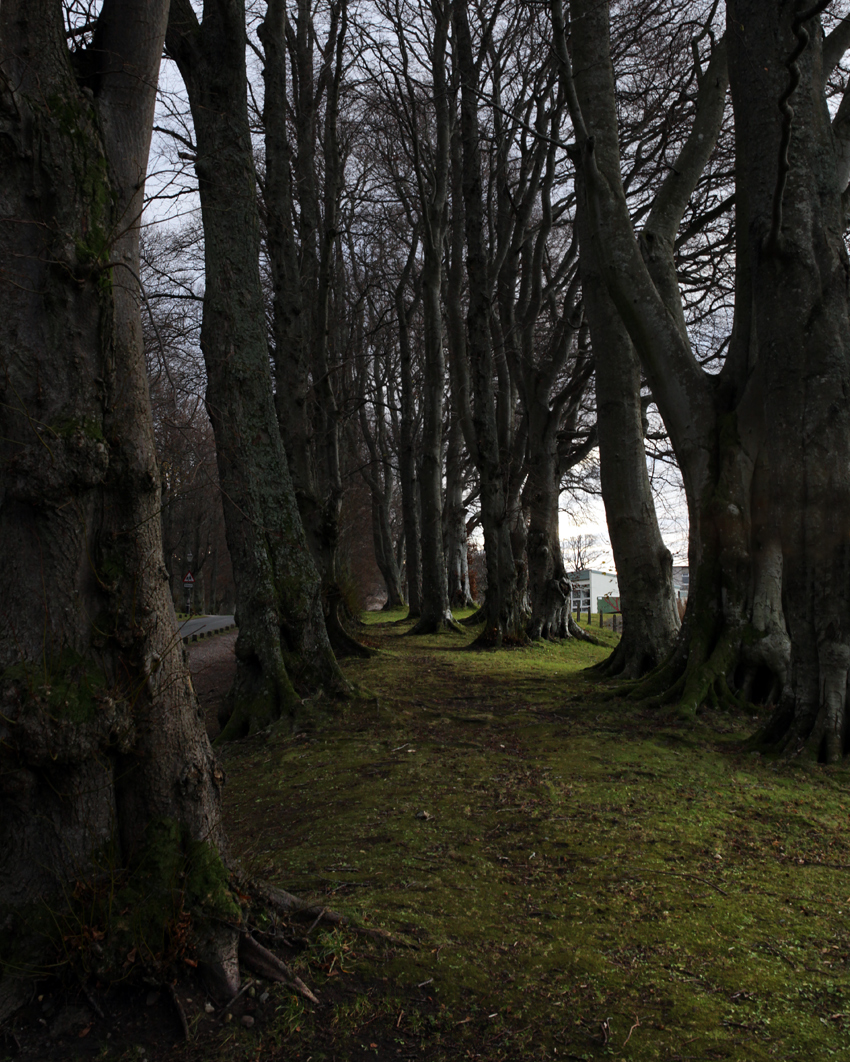 The walk back to Huntly through this line of old trees was very pleasant.
The walk back to Huntly through this line of old trees was very pleasant.
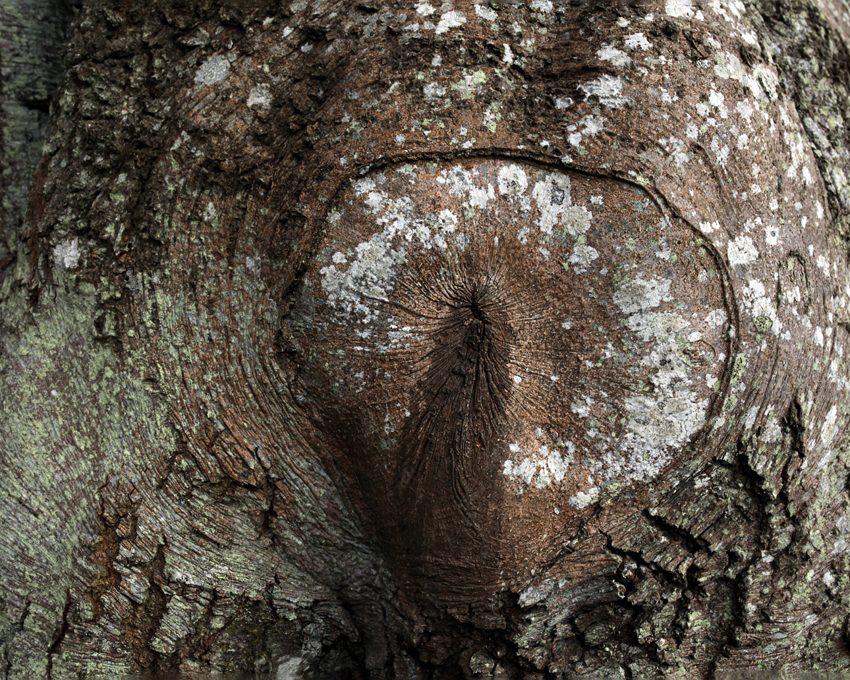 The trees, in anticipation of an icy winter, had pumped up their turgor (sap pressure) to guard against freezing. I'm glad I took that botany course in university now.
The trees, in anticipation of an icy winter, had pumped up their turgor (sap pressure) to guard against freezing. I'm glad I took that botany course in university now.
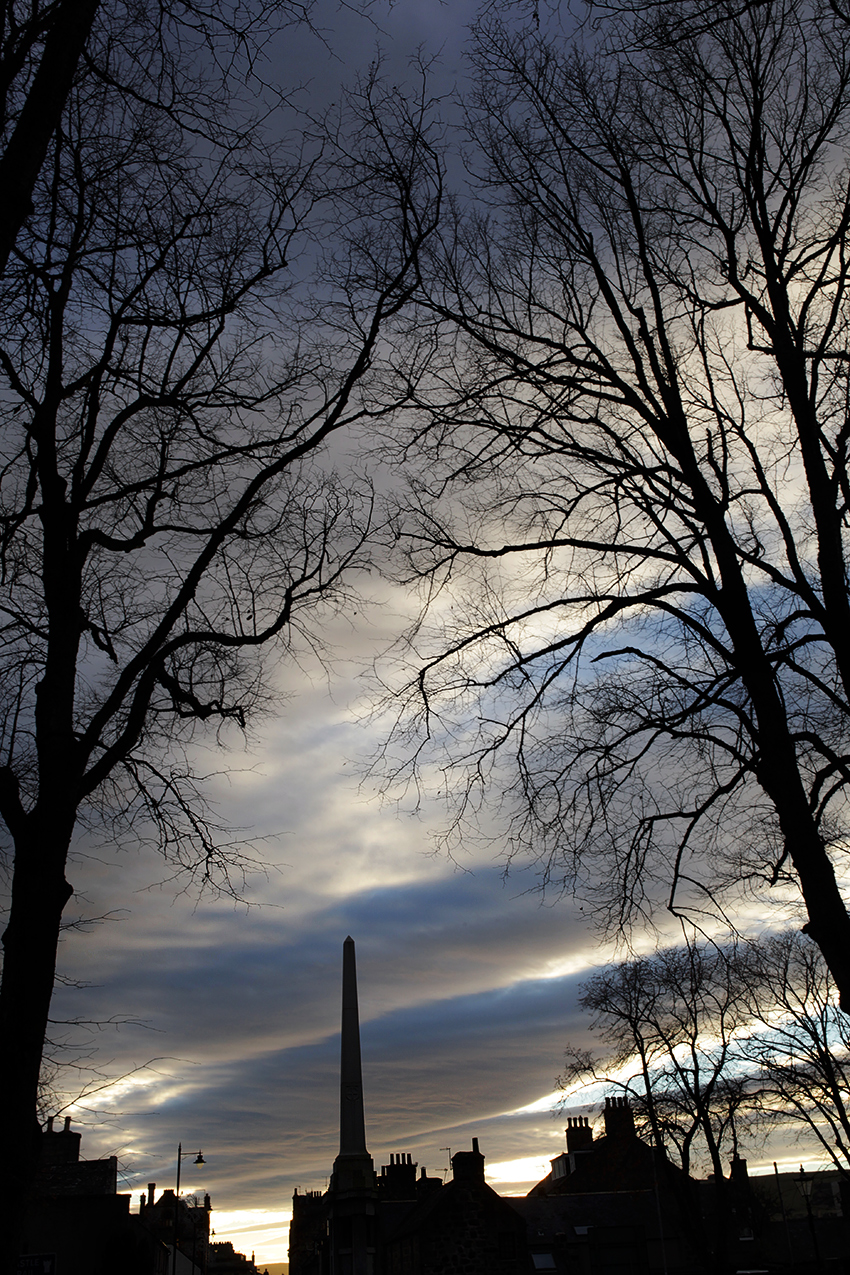 We returned to Huntly under an ever-changing light.
We returned to Huntly under an ever-changing light.
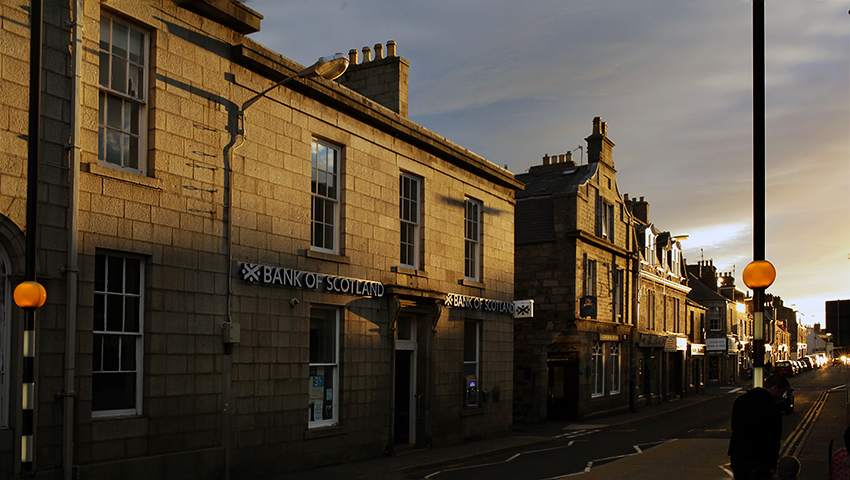 We walked through sunset-bathed Huntly, poking our noses into small shops. We stopped in one cafe for free coffee and pastries . . . it was their grand opening!
We walked through sunset-bathed Huntly, poking our noses into small shops. We stopped in one cafe for free coffee and pastries . . . it was their grand opening!
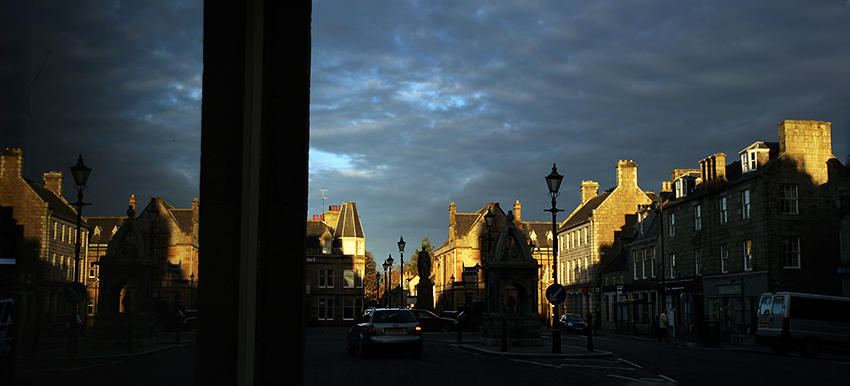 We enjoyed our day trip to Huntly, but it was time to head home. We wanted to stop at one of the Farm Stores we passed on the way . . . and I had hopes of standing in a farmer's field and shooting the rapidly developing sunset.
We enjoyed our day trip to Huntly, but it was time to head home. We wanted to stop at one of the Farm Stores we passed on the way . . . and I had hopes of standing in a farmer's field and shooting the rapidly developing sunset.
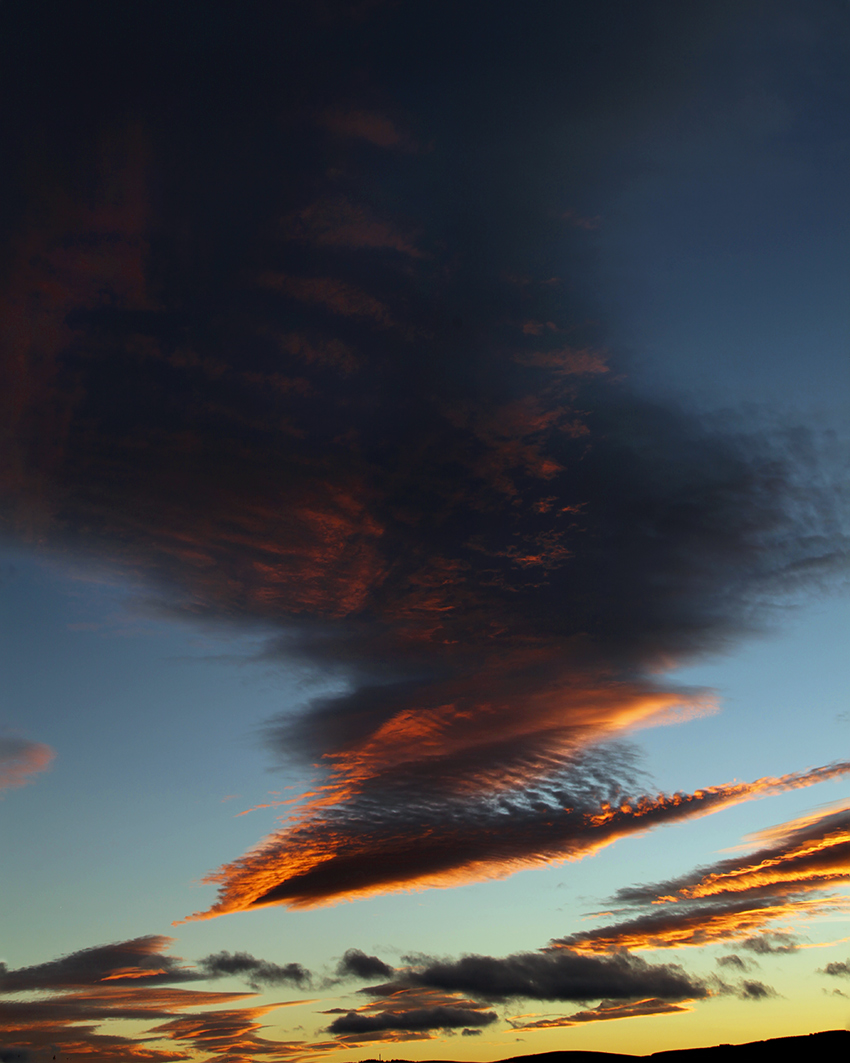 Th sunset did not disappoint! I let my darling wife off at the Farm Store and drove out into the countryside on a farmer's road.
Th sunset did not disappoint! I let my darling wife off at the Farm Store and drove out into the countryside on a farmer's road.
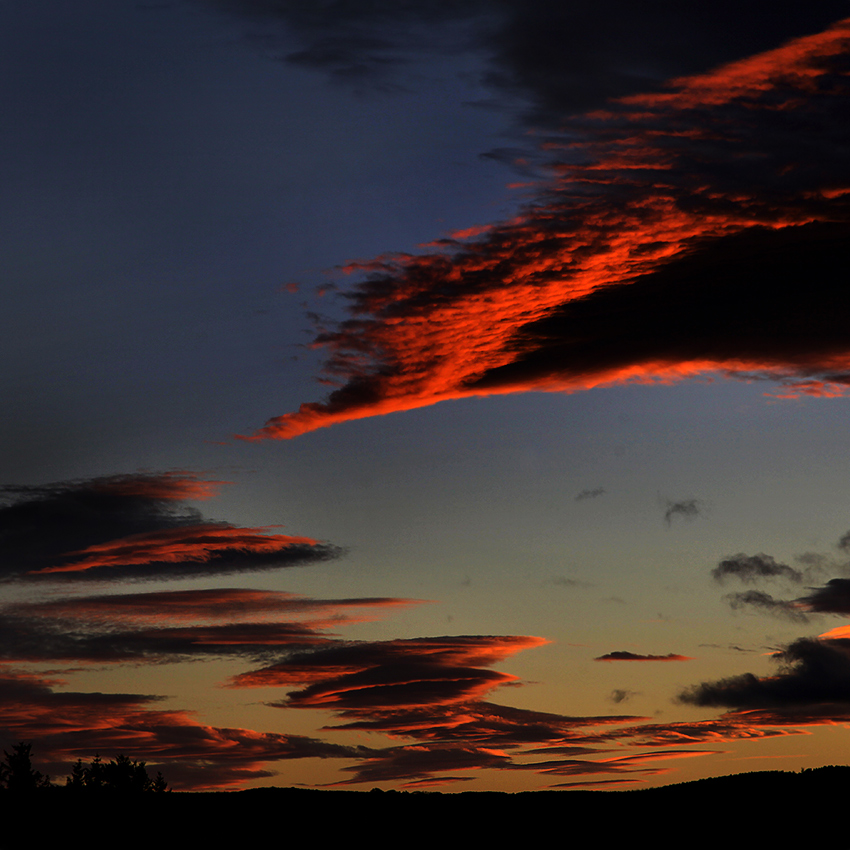 With the sun setting at such an acute angle, it took many minutes to fully develop.
With the sun setting at such an acute angle, it took many minutes to fully develop.
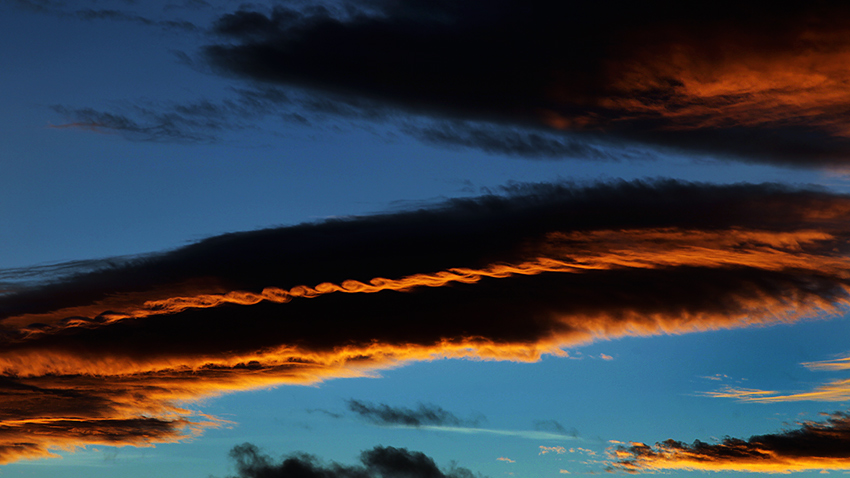 In the tropics, like Bangkok (where I lived until five months ago), a sunset would begin and end in a matter of minutes . . . .
In the tropics, like Bangkok (where I lived until five months ago), a sunset would begin and end in a matter of minutes . . . .
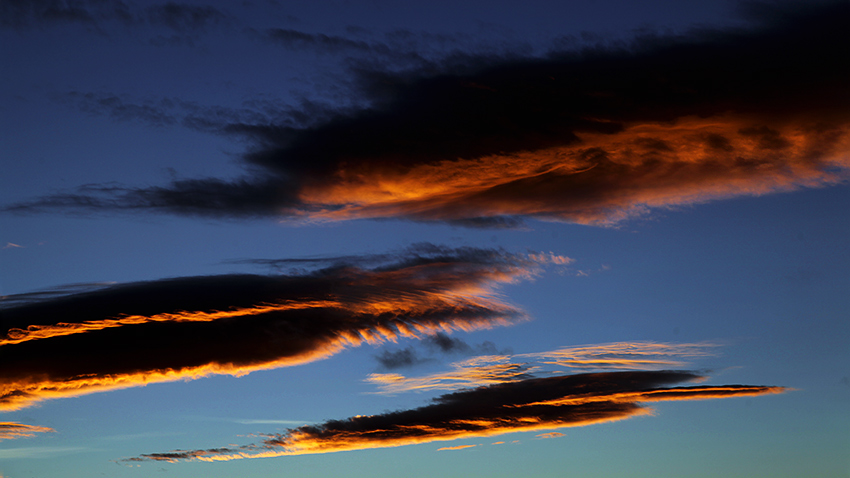 . . . but this most beautiful of sunsets lasted nearly 40 minutes.
. . . but this most beautiful of sunsets lasted nearly 40 minutes.
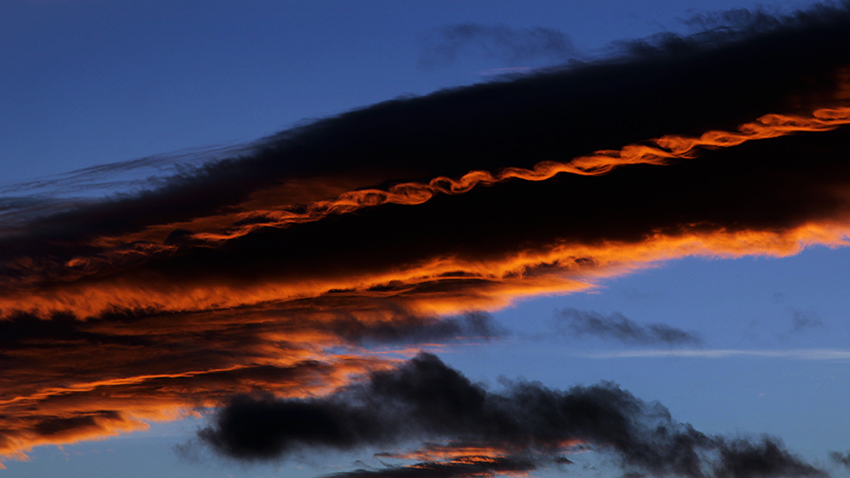 This horizontal swirling braid moved fast enough for me to see it twisting. Incredible.
This horizontal swirling braid moved fast enough for me to see it twisting. Incredible.
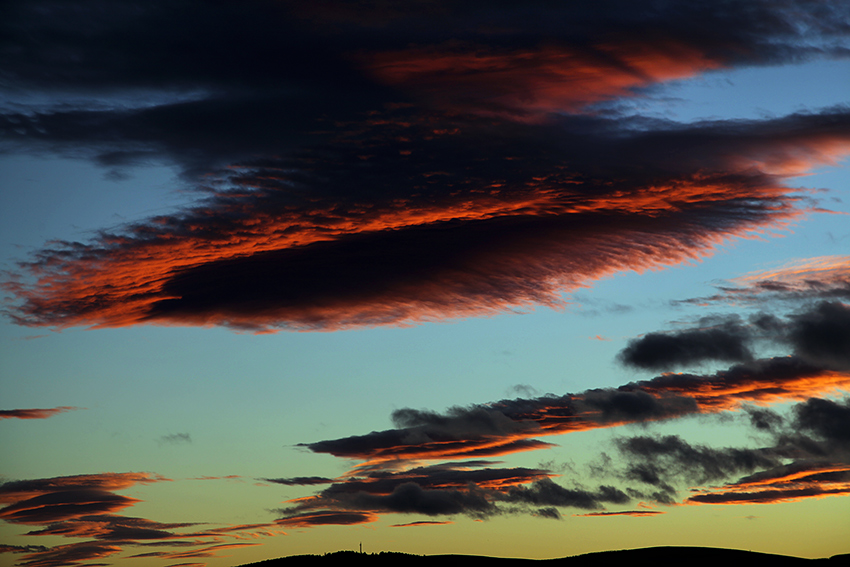 If there were such things as flying saucers, this is the cloud from which they should descend! WOW!
If there were such things as flying saucers, this is the cloud from which they should descend! WOW!
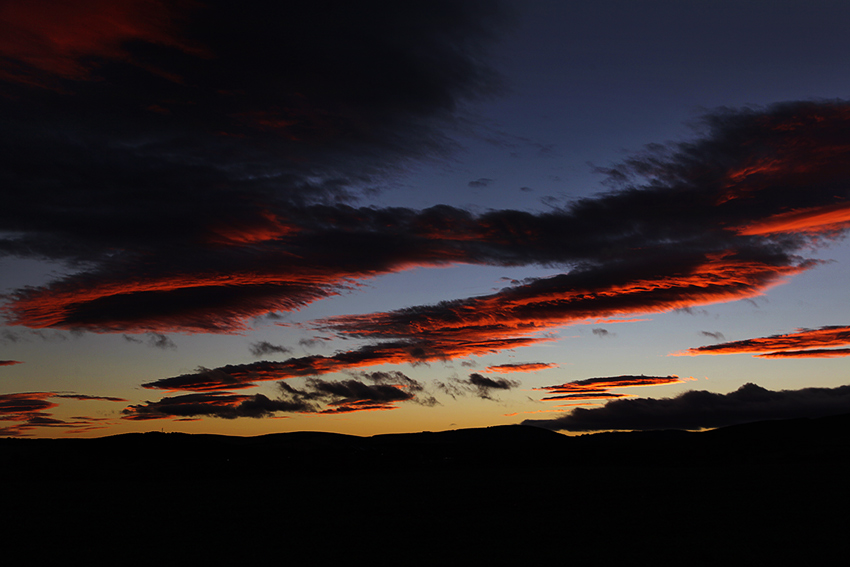 It was a big sky full of beauty.
It was a big sky full of beauty.
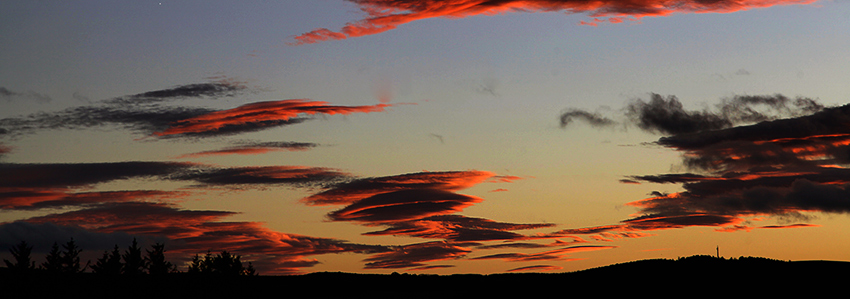 I chose the Canon 24-105mm L-series lens, and tried to keep it around f8 hand-held for clarity.
I chose the Canon 24-105mm L-series lens, and tried to keep it around f8 hand-held for clarity.
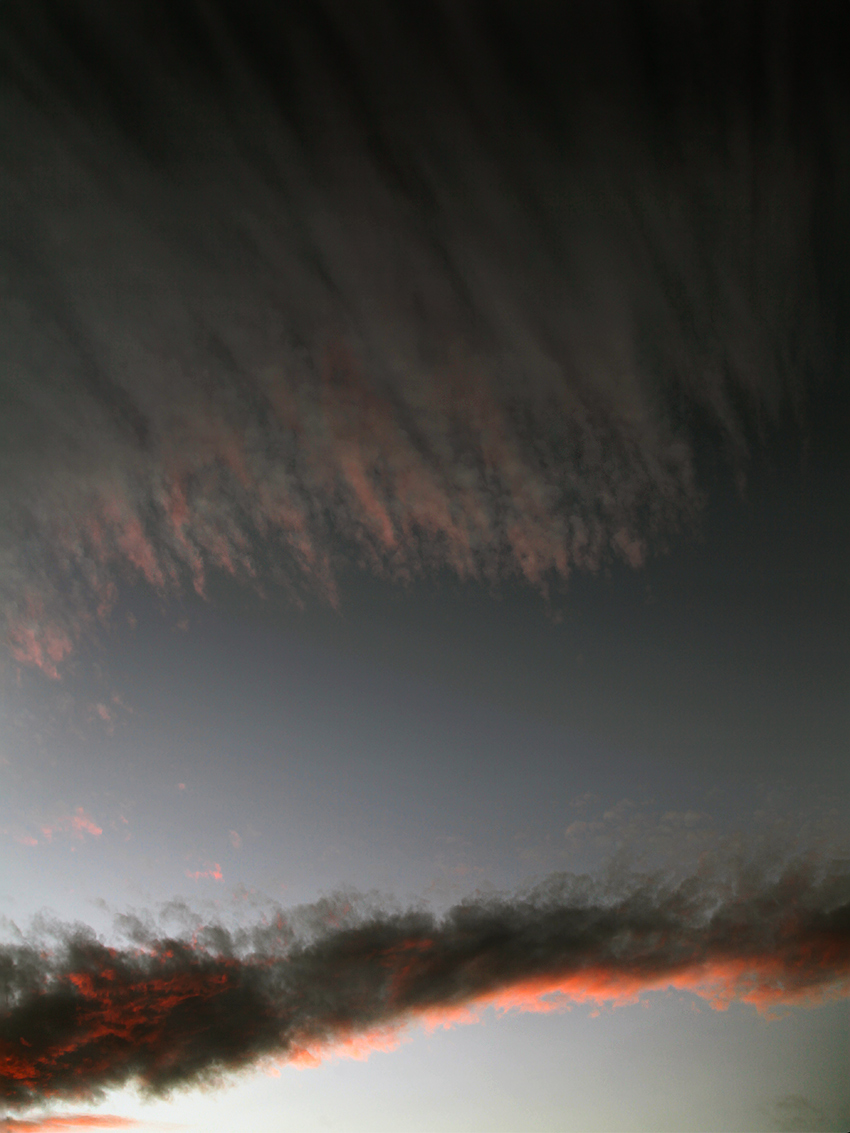 As I stood by my car getting ready to put the camera away, I happened to look straight up . . . .
As I stood by my car getting ready to put the camera away, I happened to look straight up . . . .
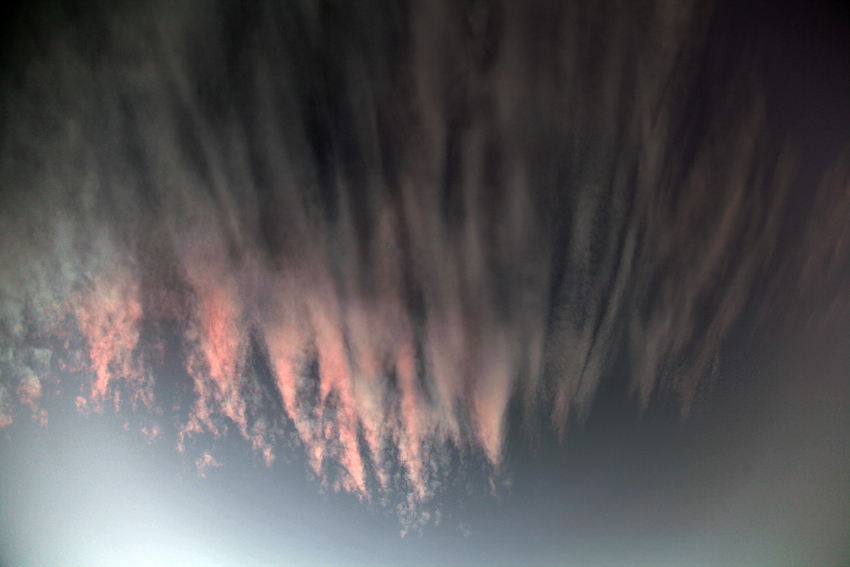 . . . and caught this shot of the reflected, and refracting, light of the sunset on ice crystals from yet another weather pattern moving in from the west. What a great way to end the day.
. . . and caught this shot of the reflected, and refracting, light of the sunset on ice crystals from yet another weather pattern moving in from the west. What a great way to end the day.
